

14 Top-Rated Tourist Attractions in the Eastern Cape
Written by Karen Hastings , Carri Wilbanks and Becca Blond Updated Apr 25, 2022
The Eastern Cape Province in South Africa is astoundingly diverse and, in parts, deliciously undeveloped. In winter, snow sometimes dusts its distinctive mountain peaks, and in summer, its sparkling coastline lures throngs of surfers, swimmers, and sun lovers.
From the sea to the inland desert, the scenery of the Eastern Cape is spectacular. And there are so many things to do: sightseers can explore everything from ancient forests and gaping valleys to craggy sea cliffs and the lush coastline stretching from the Tsitsikamma section of Garden Route National Park to the subtropical Wild Coast .
Inland, the rolling hills around Grahamstown are known as Settler Country, after the British migrants who settled these ancestral Xhosa lands in the early 19th century. Animal lovers can view a dazzling diversity of wildlife at the national parks and private game reserves, including the rare Cape mountain zebra, white lions, and rhinos. Travelers can also explore part of the Eastern Cape's coastline on the Garden Route scenic drive, which is one of South Africa's most revered routes.
Discover the best places to visit in this diverse region with our list of the top attractions in the Eastern Cape.
1. The Valley of Desolation
2. the wild coast, 3. addo elephant national park, 4. the storms river suspension bridge, 5. mountain zebra national park, 6. jeffreys bay surf break, 7. baviaanskloof wilderness area, 8. port elizabeth beaches, 9. inkwenkwezi private game reserve, 10. grahamstown: settler country, 11. owl house, 12. bloukrans bridge bungee jump, 13. route 67, 14. chintsa, map of tourist attractions in the eastern cape.
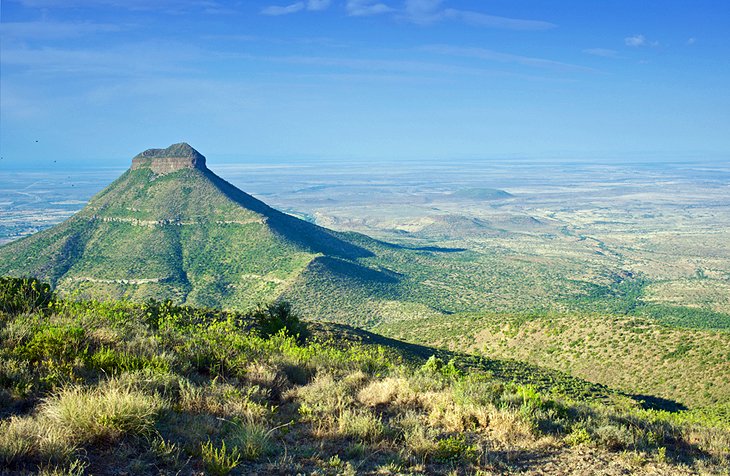
In Camdeboo National Park, which surrounds the town of Graaff-Reinet, the Valley of Desolation is one of the most striking natural features on the Eastern Cape. The access road climbs to 1,500 meters and ends at a parking area with well-maintained footpaths to panoramic viewpoints along the steep cliff face.
Here, visitors can enjoy spectacular views of towering dolomite rock pillars and the surrounding countryside where the shifting light plays upon the sweeping landscapes. To the south lie the semi-desert landscapes of the Great Karoo; to the east, Graaff-Reinet; and to the north, the distinctive peaks of the Sneeuberg Mountains.
For the best photos, visit at sunrise or especially sunset, when the deep, golden light imbues the landscapes with a honey glow. Wildlife in the park is diverse and abundant. Visitors can spot many species of birds, as well as mammals such as the Cape buffalo, kudu, springbok, and bat-eared fox.
The nearby town of Graaff-Reinet is also worth a visit for its restored Karoo-style homes and historic buildings. A highlight is Reinet House , a former parsonage in Cape Dutch style, which is now a museum with a large collection of 18th- and 19th-century furniture and farming equipment, as well as a doll collection from the First World War.
Official site: http://www.sanparks.org/parks/camdeboo/tourism/activities.php
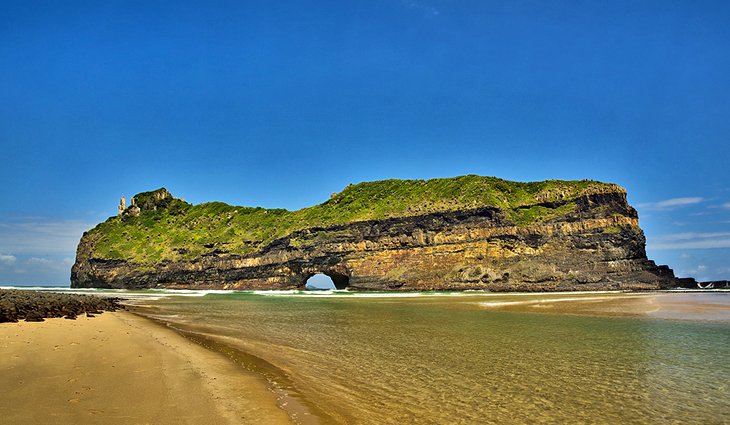
Stretching north of East London , South Africa's Wild Coast is a land of spectacular beauty. Craggy sea cliffs, wind-whipped beaches, subtropical forests, and hills cloaked in golden grass characterize this untamed wilderness, which skirts the Eastern Cape's northern coast, from the Mtamvuna River in the north to the Great Kei River in the south.
The Wild Coast is the ancestral home of the Xhosa people, as well as other tribes whose villages dapple the landscapes. During the apartheid era, the Wild Coast was part of the Transkei, one of four territories declared independent from South Africa, until it merged with the Eastern Cape province in 1994.
The best way to explore this rugged and remote region is by 4WD vehicle, but adventurous travelers can also hike along walking tracks connecting the local villages, or explore the area on horseback. Tourist highlights in the region include the popular Inkwenkwezi Private Game Reserve and the Hole in the Wall , a natural arch carved by thrashing surf .
Many travelers base themselves at towns such as Coffee Bay, Port St. Johns, and Morgan Bay and venture out into the surrounding wilderness for outdoor fun, such as ocean and river fishing, diving and snorkeling along the reefs and shipwrecks, and wildlife watching in the many nature reserves. Birding is also fantastic, with more than 320 species recorded in the region.
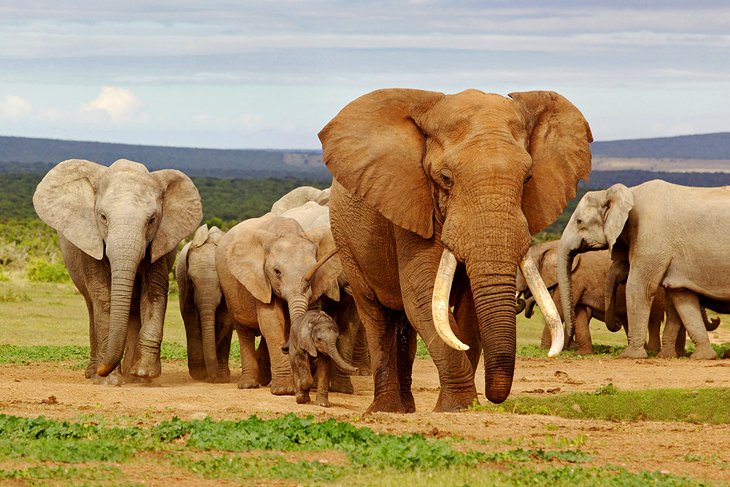
About 72 kilometers north of Port Elizabeth , Addo Elephant National Park is the third largest national park in South Africa. It was founded in 1931 to save the last 11 South African bush elephants from extinction, and today provides a habitat for more than 600 elephants, as well as a host of other fascinating creatures.
Stretching from the Karoo to the coast, the park also includes offshore islands, which are home to important breeding populations of Cape gannets and African penguins. Thanks to its diversity of ecosystems, the park's claim to fame is that it's the only national park in the world to protect the Big 7–the Big 5 (elephant, rhino, Cape buffalo, lion, and leopard) as well as the great white shark and southern right whale.
Wildlife lovers can also spot zebras, antelope, an impressive array of birds, and nocturnal animals such as porcupines, anteaters, and bush pigs. As well as guided day and nighttime game drives, visitors can enjoy other adventures such as horseback riding and hiking trails.
The park welcomes day visitors who can choose to explore the wilderness in their own vehicles or opt for a guided tour. For overnight visitors, accommodation is available in cottages, chalets, or campsites.
Official site: http://www.sanparks.org/parks/addo/default.php
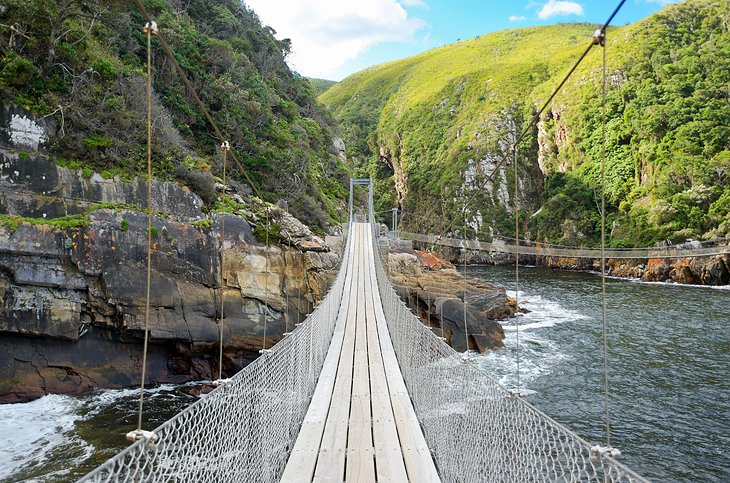
Along the famous Garden Route , a 200-kilometer-plus scenic drive, which stretches from the Eastern Cape to the Western Cape , the Storms River Suspension Bridge is one of the most popular attractions in Tsitsikamma National Park, a spectacular coastal reserve that is now part of Garden Route National Park.
The 77-meter-long bridge spans the foaming, froth-topped waters of the Storms River mouth, which swirl and splash less than seven meters below the bridge as they merge with the Indian Ocean. Standing on the bridge, visitors feel as though they are floating above the thrashing sea.
To access the bridge, visitors hike through 900 meters of beautiful bird-rich forests with waterfalls and plenty of lookout points to stop and rest while admiring the sea views. Two smaller suspension bridges lead hikers back to the pathway for their return journey. After the rewarding walk, which takes about 30 minutes each way, hungry hikers can refuel at the nearby lodge restaurant.
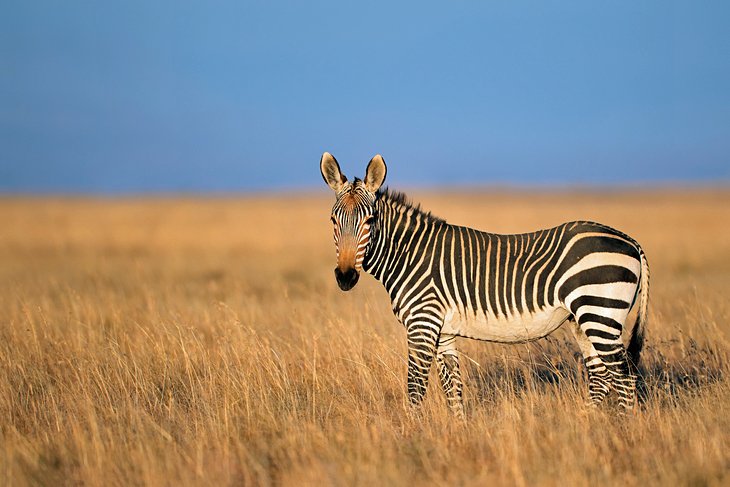
Mountain Zebra National Park offers nature lovers the chance to see a fascinating array of wildlife against the backdrop of magnificent mountain scenery. Established in 1937 to ensure the survival of the Cape mountain zebra, the park lies about 24 kilometers southwest of Cradock on the northern slopes of the Bankberg range, with peaks rising up to 2,000 meters.
In addition to a healthy population of Cape mountain zebras, which are smaller than their common counterparts, the park is also home to springbok, kudus, caracals, jackals, cheetahs, lions, Cape buffalo, black rhinos, and many species of birds. Lucky visitors might also catch a glimpse of the shy aardwolf.
Wild olives, sumac, and thorny acacias dot the arid and rocky landscapes, and the sweeping grasslands fringing the driving route allow views of grazing wildlife. Visitors can also view San (Bushman) paintings dating from about 300 years ago. Other activities include paddling in the park's swimming pools, hiking the nature trails, and exploring the 4WD tracks.
Guests can also tour the park in their own 2WD vehicles. Accommodation ranges from a guest house to family chalets and campsites, all with access to a shop and a la carte restaurant.
Official site: http://www.sanparks.org/parks/mountain_zebra/
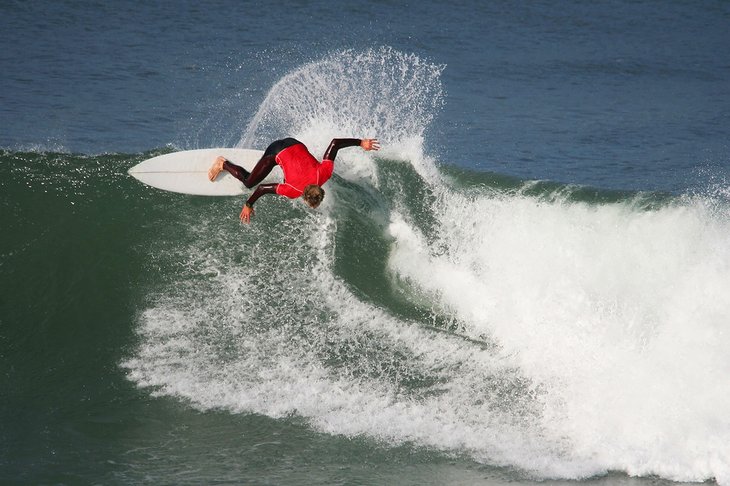
About 77 kilometers southwest of Port Elizabeth, Jeffreys Bay, affectionately called J-Bay, is one of the world's top surfing spots. In particular, the beach is known for its superb right-hand point break, a consistent and exceptionally long and fast tubing formation along the west side of the bay.
The break is divided up into sections; Supertubes is the most famous and can break for more than 300 meters. For the best swells, surfers should aim to visit between May and September when offshore winds provide ideal conditions. But for swimmers, the summer months (December through February) are the prime time, when the weather is warm and sunny, and the water warms up.
The town itself is one of the fastest growing on the Eastern Cape and is a favorite vacation destination–especially for South Africans who come here to relax on the beaches, feast on fresh seafood, and swim at the excellent Blue Flag Beach. Between June and October, whales can often be spotted offshore. At the Noorskloof Nature Reserve, an attractive footpath winds its way along a river for three kilometers where hikers may spot antelope and vervet monkeys.
Northeast of town, the Kabeljous Nature Reserve encompasses a pristine estuary with fantastic opportunities for fishing, while to the south of town, at the little resort of Aston Bay, the Seekoei River Nature Reserve is a popular destination for birders with more than 120 species recorded in the area. Nearby Paradise Beach is also a beautiful stretch of shoreline and a great spot to hunt for seashells.
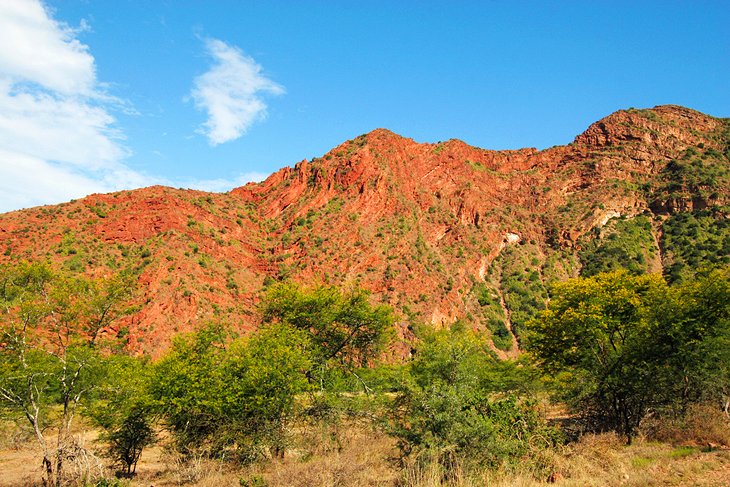
About 90 kilometers west of Port Elizabeth, the spectacular landscapes of the Baviaanskloof Wilderness Area offer a rough and rugged 4WD adventure. This UNESCO World Heritage Site is South Africa's third largest inland conservancy with an incredibly rich biodiversity. In addition to mountain zebras and Cape buffalo, nature lovers may also spot the area's namesake baboons (Baviaanskloof means "Valley of Baboons"), vervet monkeys, mongoose, and many species of birds, including fish-eagles. Hiking is also rewarding–especially for those who enjoy peace and solitude.
The most popular driving route for travelers runs from Patensie in the east to Willowmore in the west and follows the 200-kilometer-long Baviaanskloof valley with beautiful red rock and green-cloaked mountains rising to the north and south. Leave plenty of time, as the roads are weather-beaten dirt tracks that are particularly challenging after heavy rains. The route can take up to six hours to drive and even longer depending on conditions.
The route traverses two mountain passes with magnificent views, as well as low-water crossings. Four wheel drives are highly recommended and essential in parts. Basic accommodation and campsites are available for those who wish to stay overnight.
Official site: http://www.baviaans.co.za/
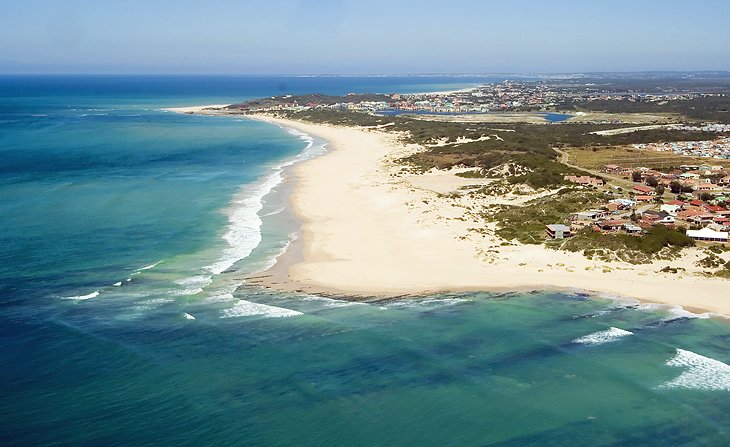
Port Elizabeth, the popular tourist town at the end of the Garden Route , features more than 40 kilometers of clean and safe surf-washed beaches along sparkling Algoa Bay. Not surprisingly, water sports are a favorite pastime.
Swimmers can paddle at a clutch of beaches boasting the coveted Blue Flag status, awarded for exemplary water quality and safety, including Kings Beach , one of the most popular thanks to its nearby restaurants and skate park. Wells Estate Beach with a paddling pool and water slides and Humewood Beach are two more options . Surfers can ride the waves at Pollock Beach , and SCUBA divers and snorkelers can immerse themselves in the underwater world at beautiful Sardinia Bay , which lies in a marine reserve.
Fishing is best along the northern beaches such as Bluewater Bay and Brighton Beach . For both swimming and windsurfing, head to Hobie Beach , near the Boardwalk entertainment complex. Depending on the time of year, visitors can also enjoy the coast aboard a whale watching cruise with the chance to spot migrating humpbacks, Southern right whales, and Bryde's whales.
- Read More: Top-Rated Tourist Attractions in Port Elizabeth
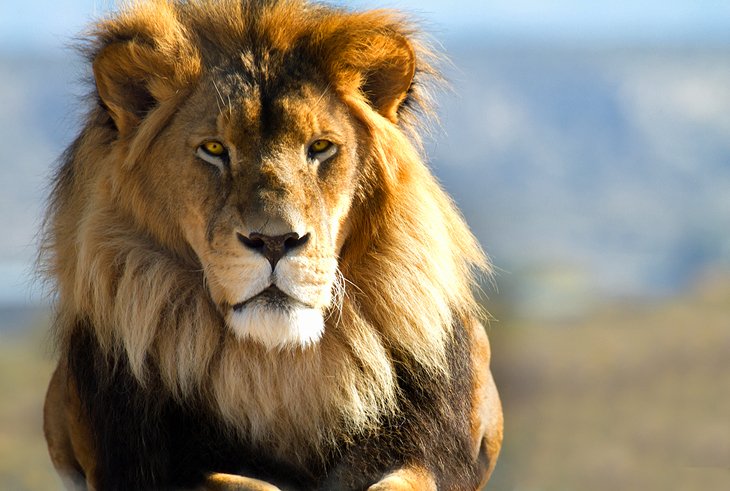
Inkwenkwezi Private Game Reserve, on South Africa's Wild Coast , about 33 kilometers from East London , offers an exhilarating safari adventure.
Thanks to its range of ecosystems, the park is home to an astounding diversity of wildlife including lions, Cape buffalo, rhinos, zebras, giraffes, and many species of antelope. Birdlife is also abundant, with more than 285 different species recorded in the park. Another highlight here are the white lions in a separate 150-hectare reserve.
Day visitors are welcome and can choose to explore the park in their own car or on a guided tour in an open-topped 4WD vehicle. Other adventure options include quad bike tours, a forest walk, and canoe trips.
Many visitors stay overnight in luxury tents that blend beautifully with the surrounding wilderness, but accommodation is also available in a nearby lodge.
Another popular choice for a plush safari is Shamwari Game Reserve about 75 kilometers from Port Elizabeth.
Official site: http://eastlondon-info.co.za/
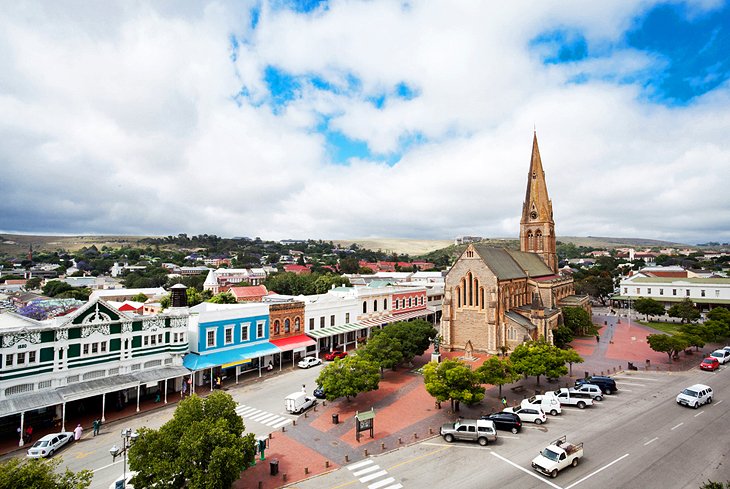
In a sheltered basin 60 kilometers from the south coast and half way between Port Elizabeth and East London , historic Grahamstown is the capital of Settler Country, where white settlers battled the Xhosa in the early 19th century. Despite its turbulent history, today Grahamstown is a vibrant cultural center thanks to Rhodes University and its many other educational institutions. The Grahamstown Arts Festival , famed throughout South Africa, is held annually at the end of June, when the town becomes a gigantic stage hosting an impressive lineup of cultural events.
Grahamstown is also often called the "city of saints," due to its many churches, which are said to number more than 40. The queen of them all is the splendid Cathedral of St. Michael and St. George with the tallest spire in South Africa.
To learn about the town's history, visitors should stop by the Observatory Museum , with a Victorian-style interior and displays of old furniture and antique telescopes. The camera obscura here, still the only one in South Africa, shows an image of the town and its surroundings in clear weather.
Another top tourist attraction here is the Settlers Monument, a modern cultural center opened in 1974, which is the venue of the popular Arts Festival. A bronze monument at the entrance depicts a settler family in typical early 19th-century dress.
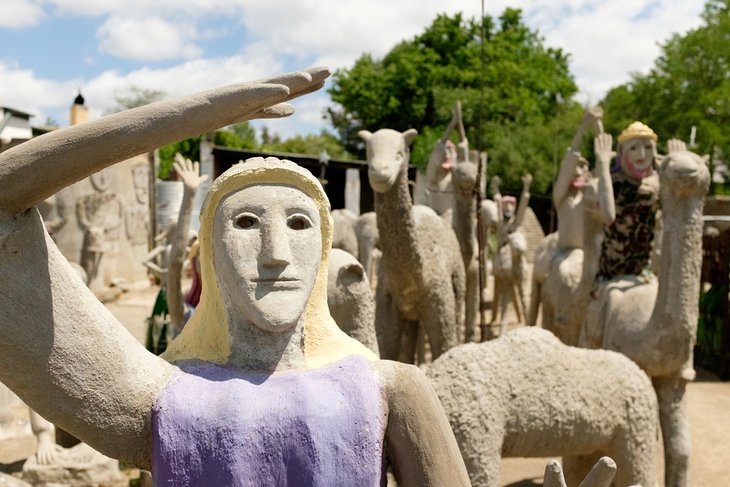
In the little hamlet of Nieu-Bethesda , about 50 kilometers from Graff-Reinert, in the heart of the Karoo is the Owl House . The quirky little museum draws in thousands of visitors to the small village each year who come to see the work of eccentric sculptor and recluse Helen Martins.
Martins lived on the property between 1945 and 1976 and during that time created hundreds of owls, camels, mermaids, pilgrims and other characters out of old bottles, pieces of cement, glass, mirrors, and wires in an effort to combat the boredom of living in the middle of nowhere. Today, you can purchase tickets to see Martins work at the Owl House and the Camel Yard out front.
Official site: https://www.theowlhouse.co.za/
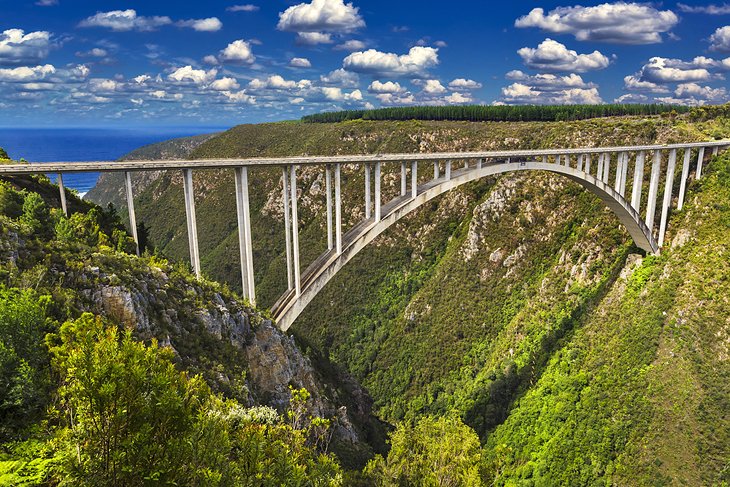
Located right at the border of the Eastern and Western Cape provinces near the town of Nature's Valley on the Garden Route , the Bloukrans Bridge is South Africa's most famous spot for bungee jumping. Spanning the Bloukrans River below, the arch bridge was constructed in the early 1980s and is the highest of its kind in the country.
The Bloukrans bungee jump is the highest commercial bungee jumping operation in the world at 216 meters –more than 700 feet. Jumping is quite an adrenalin rush, but the operation, run by Face Adrenalin, is also very safety focused. You will be wearing a full body harness with an ankle connection to minimize possibilities of injury.
If you aren't quite ready to take the leap but still want to feel a little adrenaline buzz, you can follow the walkway under the bridge to the bungee platform. Walking along, you'll get a sense of the height of the bridge without plunging off it. This is also a good spot to cheer on braver friends or family members.
Official site: www.faceadrenalin.com
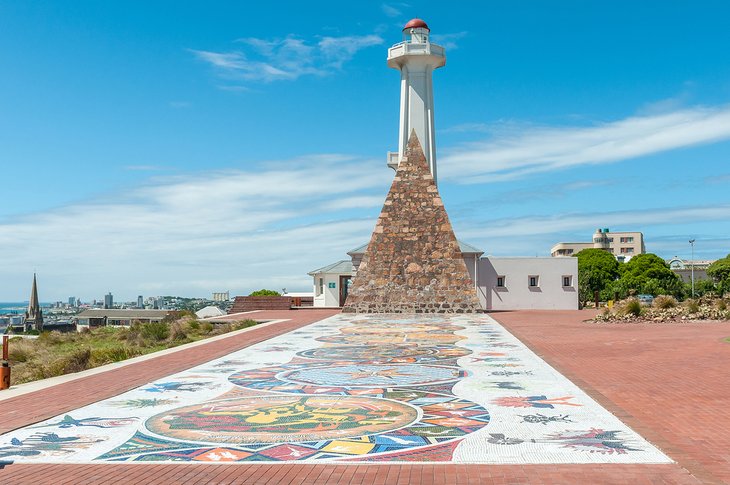
The Eastern Cape is the late Nelson Mandela's birthplace. Madiba was born in the rural village of Mvezo on the Wild Coast in 1918. Today the province celebrates Mandela's legacy with a number of attractions dedicated to him. One of the most powerful is Route 67 in Port Elizabeth .
The self-guided walking route consists of 67 pieces of art inspired by Mandela. The number 67 comes from the 67 years South Africa's first Black president devoted to public service (although more than 27 of these years were spent in prison). The route starts at the Campanile on Strand Street and ends at the Great Flag in the Donkin Reserve.
The most powerful piece on the route is the Voting Line Sculpture , which stands 38 meters high in the Donkin Reserve. It is a cut-out in steel of Mandela with his first raised in the air. It is the work of artists Anthony Harris and Konrad Geel.
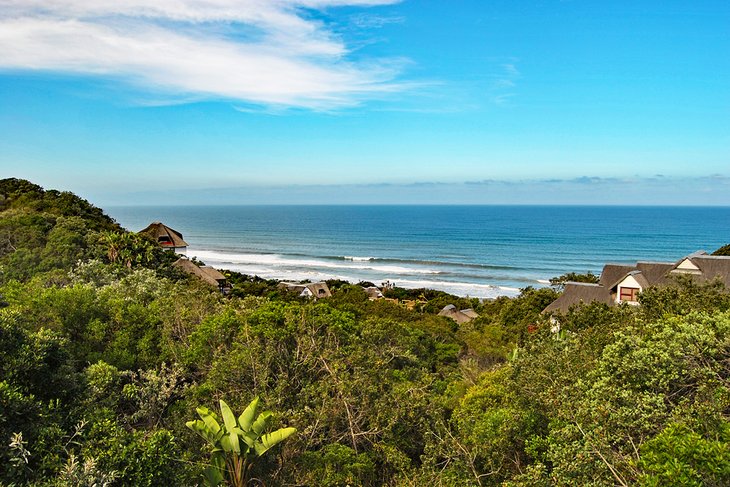
Just outside the boundaries for the Wild Coast and just 45 kilometers from East London , Chintsa is one of the most charming beach towns in the Eastern Cape. Its name comes from the river on which it sits, which means "crumbling banks" in the local Xhosa language. Backed by the rolling green hills and thick indigenous forests that give the region its wild look, Chintsa boasts a gorgeous stretch of gold-sand beach and windswept dunes. It still remains wonderfully devoid of large-scale development.
Because it sits on a lagoon, the sea here is also mostly flat with just small waves, making it a popular summer vacation spot for families. There are a handful of lodging options and restaurants in the two small villages on the Chintsa River's banks.
More Related Articles on PlanetWare.com
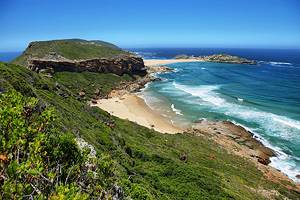
Western Cape : From the Eastern Cape head west on the N2 until you hit the Western Cape, which begins around Natures Valley on the famed Garden Route . For more on this fascinating province, see our Top-Rated Tourist Attractions in the Western Cape page. Here, you'll be introduced to all this magical province has to offer–from Africa's southernmost point, Cape Argulhas , to its most beautiful city, Cape Town.
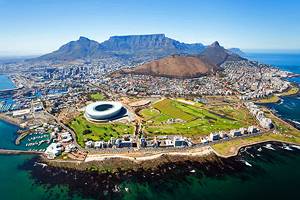
Cape Town : Cape Town is the biggest city in the Western Cape and a destination in its own right. Home to stunning scenery, lots of culture, and beautiful beaches, the Mother City dazzles. See our Top-Rated Tourist Attractions in Cape Town & Easy Day Trips guide for a more in-depth read. It will introduce you to top things to do, like riding the gondola to the top of Table Mountain and exploring the V&A Waterfront .

More on South Africa
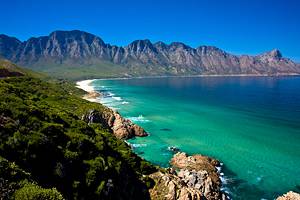

South Africa Travel Blog
The Eastern Cape Tourist Attractions: A Complete Guide

The Eastern Cape Province in South Africa offers unspoiled beaches, dense bush, and lush forests. Nelson Mandela called this province home. This province has many attractions for visitors to choose from. If you’ve wondered about the best things to do in the Eastern Cape Province of South Africa, you can find a complete guide to the Eastern Cape’s tourist attractions in this article!
Where is the Eastern Cape Province of South Africa?
See elephants in their natural habitat at the addo elephant park, see zebras in the mountain zebra national park , visit the port st john’s lighthouse , experience the wild coast of south africa, visit the idyllic hogsback – one of the eastern cape’s tourist attractions , have a safari adventure at the inkwenkwezi private game reserve, explore the tsitsikamma national park, bungee jump at the bloukrans bridge, see old cars at the st croix motor museum, visit one of south africa’s oldest towns: graaff-reinet , eastern cape tourist attraction: see the sculptures at the owl house, learn about the settlers’ history in grahamstown, learn about khoisan history at the east london museum, explore the baviaanskloof wilderness area with a 4 wheel drive, ski at the tiffindell ski & alpine resort, visit the nelson mandela museum, surf or swim in jeffrey’s bay, surf at st francis bay, see a flower wonderland at van staden’s wild flower reserve, enjoy watersports at port elizabeth’s beaches, explore route 67 – one of the eastern cape tourist attractions, hike the donkin heritage trail, hike the sacramento trail, hike the otter trail, go diving in the eastern cape province, tours to explore the eastern cape’s tourist attractions.
South Africa’s Eastern Cape Province is located in the southern central part of the country. It borders several South African provinces , with the Western Cape Province bordering it on the west, the Northern Cape Province on the northwest, the Free State Province and the small country of Lesotho in the North and the KwaZulu-Natal province to the northeast. The Indian Ocean borders it on the southeastern and southern sides.
Here is a map showing the location of the Eastern Cape Province of South Africa:
The Complete List of The Eastern Cape’s Tourist Attractions
This map shows the location of the best places to visit in the Eastern Cape Province:
Let’s discover the best tourist attractions in the Eastern Cape:
The Addo Elephant National Park is approximately 72 kilometres north of Port Elizabeth . It is the third largest of South Africa’s national parks and boasts the densest elephant population in the world.

The Park was established in 1931 to save the South African bush elephants from extinction. Currently, the Park is a habitat not only for elephants but also for a wide variety of other animals, including Cape gannets, antelope, zebras, bush pigs and African penguins. A unique feature of the Park is that it is the only Park globally where you can see the Big 7!
Did you know? The Big 7 refers to the Big 5 animals, plus the great white shark and the southern right whale. The Big 5 include elephants, rhinos, leopards, lions and Cape Buffaloes.
Some of the visitors’ favourite activities at the Park include horseback riding, hiking trails and guided day and nighttime game drives. You can also be a day visitor and explore the Park in your own vehicle or through a guided tour. The Park offers accommodation in campsites, chalets and cottages.
Click here for accommodation options near Addo Elephant Park.
Read here about a unique interaction with elephants at an Elephant Sanctuary .
The Mountain Zebra National Park is approximately 24 kilometres from the small town of Cradock . The Mountain Zebra National Park was established in 1937 to protect the habitat of the Cape Mountain zebra. It currently hosts many other animal species, including cheetahs, rhinos, buffaloes and lions. Visitors can enjoy 4×4 trails or hike in this national Park. The Park offers cottages or camping as accommodation options.
Click here for accommodation options near the Mountain Zebra National Park .
When you visit Port St Johns , definitely visit the Hermes Lighthouse . This lighthouse was built from stone in 1903. It was named after the HMS Hermes that monitored the Pondoland coastal waters to warn passing ships of the rugged rocks in the bay of danger on the East Coast of South Africa. Other attractions in Port St John include the Umzimvubu River , the mountains, gorges and forests.
Click here for accommodation options near Port St Johns .
If you’re looking for adventure, the Wild Coast is the place to visit! The Wild Coast is an area of exceptional natural beauty. It features rolling green hills, countless beaches with isolated bays and waterfalls flowing into the ocean.
The Wild Coast is the ancestral home of the Xhosa people. During apartheid, it was part of the Transkei, a territory independent of South Africa. It became part of the Eastern Cape Province in 1994 when apartheid ended.

You need a four-wheeled drive vehicle to explore the Wild Coast fully. The region offers hiking tracks connecting the local villages, but you can also explore the trails on horseback.
Some famous attractions in the Wild Coast are the Inkwenkwezi Private Game Reserve and the Hole in the Wall , an arch carved naturally by thrashing surf.
Coffee Bay , Morgan Bay or Port St. Johns is the best base town for exploring the Wild Coast.

You can find the Hogsback in the Amathole Mountains with lush forests surrounding them. The Hogsback has three scenic peaks overlooking the village. This charming place is popular with local and international visitors because of its beautiful gardens and cosy cottages. There are many hiking trails to explore in the forests and the mountains here, several offering stunning panoramas of the Amathole Mountains.
Click here for accommodation options for the Hogsback .
The Inkwenkwezi Private Game Reserve houses a fantastic array of wildlife, including Cape Buffalo, lions, zebras, giraffes, rhinos, and antelope. There is a separate 150-hectare reserve for white lions. It also has an abundance of birdlife, with over 285 different species.
Day visitors can do a self-drive tour or take a guided tour in an open-topped 4WD vehicle. Other activities here include a forest walk, canoeing and quad bike tours.
Click here to see the accommodation options near the Inkwenkwezi Private Game Reserve .
At the end of South Africa’s Garden Route , you can find the Tsitsikamma National Park, with its beautiful coastlines, dense forests and glistening rivers leading to the ocean. Nature lovers can hike, kayak, snorkel or mountain bike here.

One of the famous attractions in the Tsitsikamma National Park is the Storms River Suspension Bridge. This bridge is 77 meters long and crosses the foaming waters of the Storms River mouth. Visitors hike through forests rich with bird life, waterfalls and viewpoints to get to the bridge.
Click here for accommodation options near the Tsitsikamma National Park .
Staying in Storms River Village allows you to explore the Tsitsikamma National Park and surrounding attractions. Here is a sample Garden Route itinerary to use for inspiration.

Visitors can find the Bloukrans Bridge in the Eastern Cape Province of South Africa near Nature’s Valley on the Garden Route. It is the highest single-span arch bridge and commercially operated bungee jump globally. For those not interested in jumping, walk to the top of the bridge’s arch for panoramic views of the area. You will feel the adrenaline flowing when you jump off this 216-metre-high bridge.
Click here for accommodation options near the Bloukrans Bridge .
Car lovers must visit the St Croix Motor Museum in Newton Park, Port Elizabeth . They can view vintage and classic vehicles from as early as the 1900s. There are more than 80 cars on display from the early 1920s to the late 1960s. The museum also displays other motor-industry artefacts. This museum is only open on Saturday afternoons. If you want to visit during the week, make an appointment at +27 83 463-5285.
Here are accommodation options near the St Croix Motor Museum .
Graaff-Reinet is one of South Africa’s oldest towns . The Dutch East India Company established the town in 1786. A visit to Graaff-Reinet takes you to many historic buildings and cultural landmarks. Here, you can see the restored Karoo-style homes and buildings, such as the Reinet House in the Cape Dutch style. The Reinet House is a museum with furniture and farming equipment from the 18th and 19th centuries. It also houses a doll collection from World War I.

Another must-see destination near Graaff-Reinet is the Camdeboo National Park . The views and landscapes in this national Park can be jaw-dropping and include sights such as the Valley of Desolation and the Cathedral of Mountains . You can also mountain bike or hike here. For something different, try windsurfing at the Nqweba Dam .
Here are some accommodation options near Graaff-Reinet .
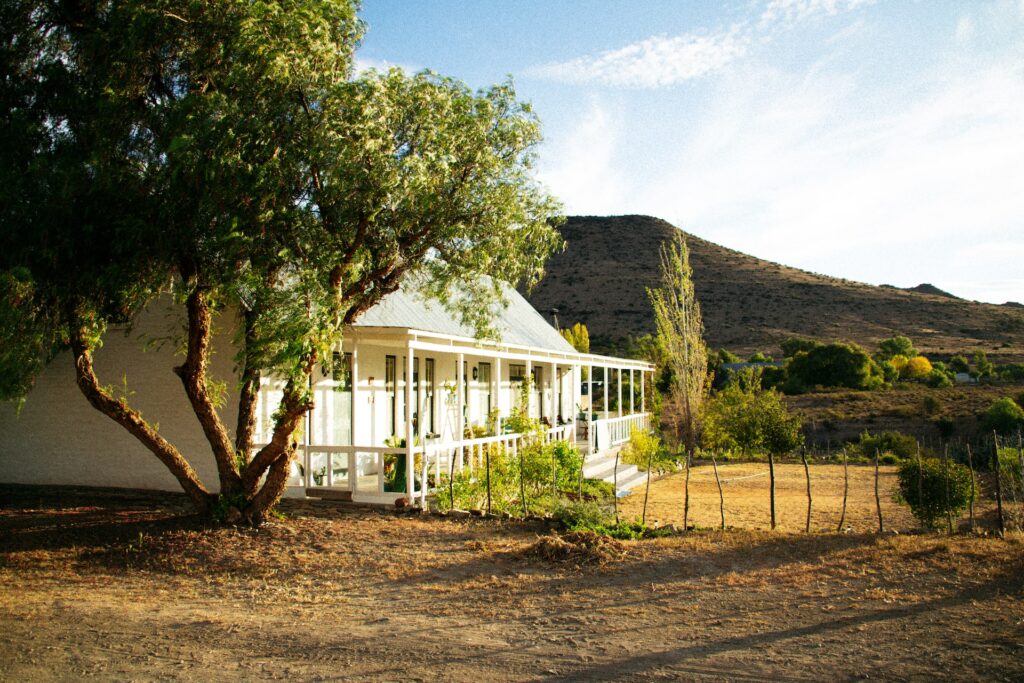
You can find the Owl House in the small town of Nieu-Bethesda , near Graaff-Reinet. The Owl House is a quirky museum that attracts many visitors to the village each year to see the sculptures of the eccentric sculptor and recluse Helen Martins . Helen lived on the property between 1945 and 1976. She created hundreds of sculptures of owls, mermaids, camels, pilgrims and other characters using old bottles, cement pieces, glass, mirrors, and wires.
Click here for accommodation near Nieu-Bethesda .
Grahamstown ‘s name changed in June 2018 to Makhanda, a legendary Xhosa warrior and prophet. It is a historic university town where the white settlers and Xhosa battled in the early 19th century. The town is known as the “city of saints” because it has more than 40 churches. The best-known church is the impressive Cathedral of St. Michael and St. George’s Cathedral , with the tallest spire in South Africa.

Visitors can learn about the town’s history at the Observatory Museum , which boasts a Victorian-style interior with displays of antique telescopes and old furniture. It also has the only camera obscura in South Africa, showing an image of the town and its surroundings in clear weather.
What is a camera obscura? According to Wikipedia, a camera obscura is a darkened room with a small hole or lens on one side, through which an image is projected onto a wall or table opposite the hole.
The Settlers Monument is another popular tourist attraction. It is a cultural centre that opened in 1974 and is the venue of the annual Arts Festival. The National Arts Festival is the largest on the content of Africa. There is a bronze monument at the entrance that depicts a settler family in the dress of the early 19th century.
Learn here about the accommodation options in Grahamstown .
To learn more about the region’s history, visit the East London Museum . Here, you can gain an understanding of the Khoisan people and the battles between the Xhosa and the British during the 19th-century Frontier Wars.
Click here for accommodation near the East London Museum .

The Baviaanskloof Wilderness Area is approximately 90 kilometres from Port Elizabeth . It is the perfect destination for a 4WD adventure and is one of South Africa’s UNESCO World Heritage Sites . Furthermore, it is the third-largest inland conservancy in the world. You can spot mountain zebras, Cape buffalo, mongoose, vervet monkeys and many species of birds, such as fish-eagles, here.
Click here for accommodation near the Baviaanskloof Wilderness Area .
South Africa only has one (snow) ski resort, Tiffindell Ski & Alpine Resort. The resort is located on the Ben McDhui mountain peak of the Drakensberg Mountains . It is open year-round and has facilities for skiing & snowboarding.
Here are the accommodation options near Tiffendell Ski Resort .
The Eastern Cape is where the late President Nelson Mandela was born. He was born in Mvezo on the Wild Coast in 1918. The Nelson Mandela Museum is in the town of Mthatha . The museum has two main sites: the Nelson Mandela Youth and Heritage Centre in Qunu and the Bhunga Building in Mthatha . A third site, Mvezo, is not operated by the museum. It gives visitors a cultural experience with insights into Nelson Mandela’s life. Visitors can do guided tours and a heritage trail following in his footsteps.
Here are accommodation options near the Nelson Mandela Museum in Mthatha.
Surfing in The Eastern Cape Province
The Eastern Cape is a haven for surfers and swimmers. It offers several excellent spots for surfing, such as:

Jeffrey’s Bay , or J-Bay, is known internationally for the best right-hand surf break in the world! Every year many international renown surfers come to Jeffrey’s Bay to try its challenging Surf Break. Apart from surfing, Jeffreys’ bay offers beautiful blue flag beaches, reefs and views of dolphins. You will find many craft shops near the surf shops and beaches.
Here are Jeffrey’s Bay’s accommodation options.

St Francis Bay is a popular surfing destination for experienced surfers. Many consider St Francis Bay the place for the best waves in South Africa. The waves at Seal Point, near the Seal Point Lighthouse , start from ground swells but have an angle from the South Easterly direction, producing the best swell.
Here are St Francis Bay’s accommodation options.
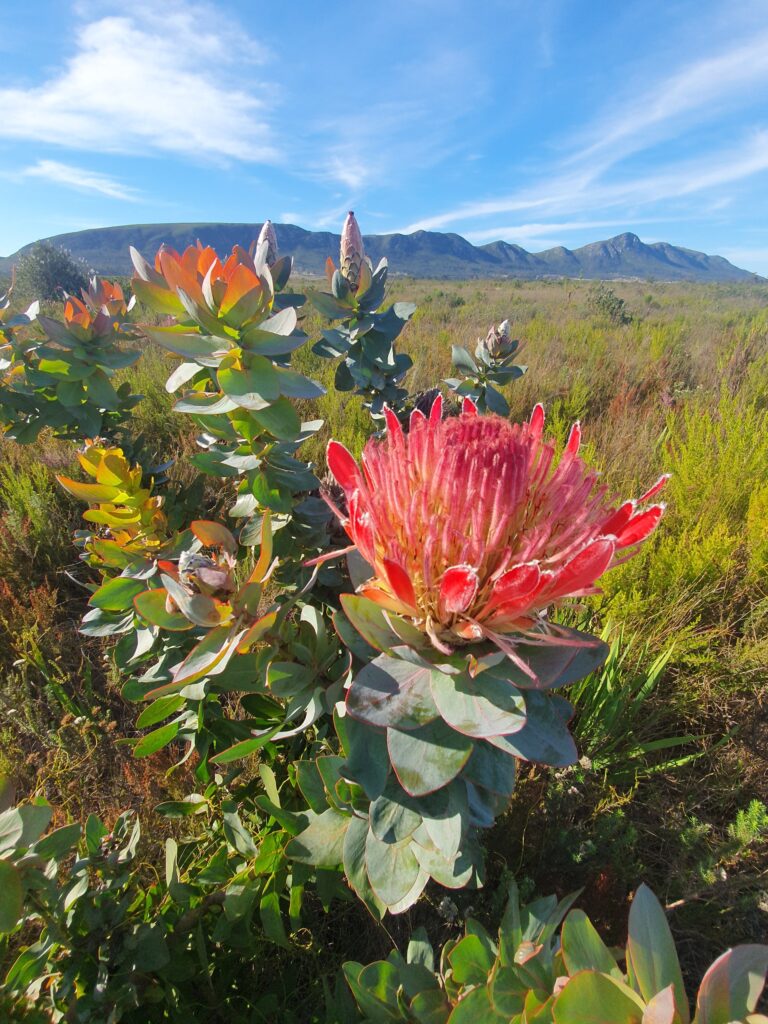
The Van Staden’s Wild Flower Reserve is a 500-hectare reserve approximately 40 kilometres from Port Elizabeth . It offers a combination of natural vegetation and cultivated floral areas where the reserve propagates indigenous plants and flowers. Visitors can do bird-watching, hiking, biking or have picnics here.
Here are the accommodation options near Van Staden’s Wild Flower Reserve.

Port Elizabeth has over 40 kilometres of safe blue-flag beaches, such as Kings Beach , Wells Estate Beach and Humewood Beach . Pollock Beach is perfect for surfing, while Sardinia Bay is an excellent spot for diving and snorkelling. Bluewater Bay and Brighton are each well-liked by anglers, while Hobie Beach is popular with windsurfers.
Here are the accommodation options in Port Elizabeth.
Read here about the best beaches in Cape Town .
Route 67 in Port Elizabeth celebrates Mandela’s legacy with several attractions dedicated to him. It is a self-guided walking route of 67 pieces of art inspired by Mandela. The number 67 represents the 67 years Mandela served the public (including his 27 years in prison).
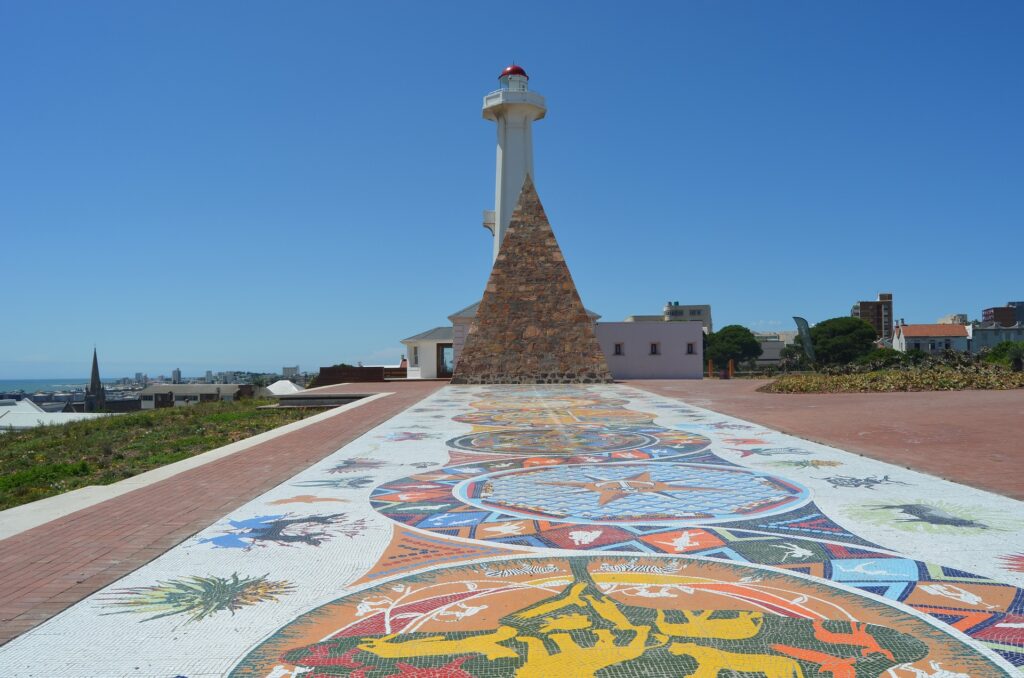
Route 67 starts at the Campanile on Strand Street and ends at the Great Flag in the Donkin Reserve . The most impressive art piece is the 38-metre-high Voting Line Sculpture in the Donkin Reserve. It is a steel cut-out of Mandela with a raised fist.
Here are the accommodation options in Port Elizabeth.
Go Hiking in The Eastern Cape Province
There are several hikes you can choose to do in the Eastern Cape Province:
The Donkin Heritage Trail is a short, easy 5-kilometre hiking trail in Port Elizabeth . You can follow in the footsteps of the 1820 settlers to the area and pass over 47 historical sites in Port Elizabeth, such as the Donkin Lighthouse , Donkin Pyramid , Port Elizabeth City Hall , market square and Fort Frederick . Get a map of the trail at the tourist office at the Donkin Lighthouse.
The Sacramento Trail is in the Sardinia Bay Nature Reserve . It is 8 kilometres long and follows the coastline between Schoenmakerskop and Sardinia Bay. From the trail, you can see dolphins and gannets in the ocean.
The Otter Trail is one of the Eastern Cape’s tourist attractions. It is a well-known hiking trail in the Tsitsikamma National Park from where hikers can see porpoises, whales and dolphins swimming in the nearby ocean.
One of Nelson Mandela Bay’s most popular diving spots is Bell Buoy Reef near Hobie Beach . The Bell Buoy Reef has a depth of 20 meters.
Here are some of the exciting tour options to explore South Africa’s Eastern Cape tourist attractions:
- Wild Coast 5 Day Hike – Port St Johns to Coffee bay, Lubanzi and Bulungula
- Tsitsikamma National Park Day Tour
- Addo Elephant National Park All Inclusive Full-Day Safari
- Tsitsikamma: Bungee Jump with Zipline and Sky Walk
- Garden Route 5-Day Tour and Addo Elephant Park Safari
- Sandboarding Jeffreys Bay

Editor of the South Africa Travel Blog that focuses on travel to South Africa, including destinations, attractions, accommodation, food & drink.
Leave a comment Cancel reply
Your email address will not be published. Required fields are marked *
Save my name, email, and website in this browser for the next time I comment.
Privacy Overview

The Top 18 Things to Do in South Africa’s Eastern Cape Province
:max_bytes(150000):strip_icc():format(webp)/DSC00412-5b73daf7c9e77c0057ca2198.jpg)
Overseas visitors to South Africa tend to throng to Cape Town (in the Western Cape), the Kruger (in Limpopo and Mpumalanga), or Durban (in KwaZulu-Natal ). Meanwhile, the oft-overlooked Eastern Cape province is one of the most rewarding destinations the country has to offer. Geographically, it is incredibly diverse. Within its borders, you can find areas of arid semi-desert, mountains capped with snow, rolling grasslands filled with game, and of course, a spectacular coastline studded with sun-soaked beaches. There is also plenty to discover from a cultural perspective, from Nelson Mandela’s Xhosa homelands to colonial cities like Port Elizabeth and Makhanda. In this article, we look at some of the best ways to spend your time in this magical area of South Africa.
Discover Colonial History in Port Elizabeth
michaeljung/ Getty Images
There are many reasons to visit the province’s largest city, Port Elizabeth, including Blue Flag beaches and several excellent restaurants. For many, the city’s colonial history is its biggest draw. PE was founded by the British in 1820 and named after the wife of the Cape Colony's Acting Governor. The landing site of the 1820 Settlers is marked by a monument known as the Campanile, while Elizabeth Donkin is commemorated with a stone pyramid at the Donkin Reserve. The Reserve also sells maps for the 3.1-mile (5-kilometer) Donkin Heritage Trail , which connects 51 colonial landmarks and Victorian architectural sites.
Tick Off the Big Five at Addo Elephant National Park
Jessica Macdonald
Just outside PE lies Addo Elephant National Park . This vast tract of protected land provides a sanctuary for the Big Five (lion, leopard, elephant, buffalo, and rhino). In particular, the park is famous for its huge elephant herds, which sometimes congregate at the waterholes in groups of 200 or more on hot days. Many other animals can also be spotted at Addo, in addition to more than 400 bird species. You can opt to join a guided game drive, or save money by driving yourself around its well-maintained roads. Self-drive safaris costs 307 rand for adults and 154 rand for children.
Experience 5-Star Luxury at a Private Game Reserve
Courtesy of Shamwari Game Reserve
In addition to national parks like Addo, the Eastern Cape has more than its fair share of private game reserves . Private reserves have their own five-star accommodations, and are only open to paying guests. Therefore, they offer a more exclusive safari experience for the luxury traveler. Two of the top names in the Eastern Cape include Kariega Game Reserve and Shamwari Game Reserve . Kariega is special because it is located a 15-minute drive from some of the most beautiful beaches in the province. Shamwari is home to a famous Wildlife Rehabilitation Center. Both offer a choice of elegant lodges with gourmet dining and spa services.
Check Out East London’s Growing Culinary Scene
istetiana/ Getty Images
The Eastern Cape may not have as many fine-dining restaurants as Cape Town and its surrounding winelands, but cities like East London have increasingly exciting culinary scenes. Locals and visitors flock to Sanook , a gourmet pizza, pasta, and burger restaurant with two branches—one in Berea, the other in Beacon Bay. Cantina & Craft offers a contemporary take on classic Mexican cuisine while The Cricketer is locally renowned for its prime South African steaks. Artisan cafe fare is also on the rise, thanks to quirky locations like open-air Lavender Blue Market and independent brunch spot Ginger & Co .
Explore the Spectacular Beaches of the East Coast
Jessica Macdonald
There are literally hundreds of astonishingly beautiful beaches in the Eastern Cape, most of them with endless golden sands and very few people. Some of the most beautiful are scattered along the stretch of shoreline known as the East Coast, which extends north of East London and includes Gonubie, Kwelera, Chintsa, Cefane, Double Mouth, Morgan Bay, and Kei Mouth. Gonubie is the closest to East London and the most populated. It’s particularly famous for whale sightings in winter. Kwelera is a haven for fishermen and surfers alike, while Morgan Bay’s magnificent stretch of sand is flanked on one end by dizzying cliffs.
Learn About Xhosa Culture in the Transkei
The Transkei region stretches from the Great Kei River to the Umtamvuna River on the KwaZulu-Natal border. During apartheid, it was designated as one of two Xhosa homelands and considered separate from white South Africa. Many of the freedom fighters who helped bring apartheid to an end were born there, including Oliver Tambo, Walter Sisulu, and Nelson Mandela. Today, the Transkei is part of South Africa once more but retains its rich Xhosa heritage. Villagers still wear tribal dress, live in traditional rondavels and perform age-old ceremonies. The Nelson Mandela Museum offers cultural experiences in Mthatha and Qunu.
Revel in the Untamed Beauty of the Wild Coast
~UserGI15667539/ Getty Images
The coastline between the East Coast and Port Edward is known as the Wild Coast for its undeveloped, untamed beauty. Sheer cliffs, pounding surf, tangled coastal forests, and magnificent natural features make it one of the most visually impressive regions of the Eastern Cape. Particularly photogenic places include Hole in the Wall , a sea arch created by millions of years of erosion near Coffee Bay. Magwa Falls near Lusikisiki is another highlight, as is Port St. Johns, with its pristine beaches and twin mountains flanking the Umzimvubu River. Hiking, fishing, and nature photography are all popular pastimes on the Wild Coast.
Witness the Sardine Run, One of Nature’s Great Events
Every year between June and July, Eastern Cape ports like Port Elizabeth, East London, and Port St. Johns welcome dive operators from all over the country. They come to take part in the Sardine Run , an annual migration of billions of sardines that attracts marine predators such as dolphins, seabirds, sharks, whales, seals, and more. You can watch the action from the surface or plunge into the melee and witness firsthand as the predators herd the hapless sardines into bait balls, ready to be picked off and eaten. Trusted Sardine Run operators include Aliwal Dive Centre and African Dive Adventures .
Ride World-Class Waves in Jeffreys Bay
TripSavvy / Jess Macdonald
There are many epic surf spots in South Africa, but the Eastern Cape boasts the most famous: Jeffreys Bay. This idyllic beach resort hosts the World Surf League’s annual J-Bay Open and has received the stamp of approval from international greats like Kelly Slater, Mick Fanning, and Jordy Smith. Supertubes is the top spot for experienced surfers, with waves that reach 12 feet and perfect barrels. Next-door Boneyards also operates, while Point offers slightly less intimidating waves and a much longer ride. The swell at Jeffreys Bay works best in the South African winter (June to September).
Go On a Birding Trip Around Port Alfred
Birders are spoiled for choice in the Eastern Cape, with rewarding birding to be had almost everywhere. However, the Port Alfred area is home to two particularly knowledgeable guides: Tim Cockroft and Anne Williams . Birding with pros like these means that you’ll have assistance identifying birds by sight and sound, and you’ll also get access to private land and secret hotspots. A rich variety of habitats around Port Alfred means that the possibilities for sightings are endless, from coastal waders to forest-dwelling endemics. Bucket list species include the elusive Narina trogon, the colorful Knysna turaco, and the tiny pygmy kingfisher.
Look for Endangered Species in Mountain Zebra National Park
Situated in the arid high country near Cradock, Mountain Zebra National Park may not have as many big game species as Addo, but it does have some rather special ones. The park was originally formed as a sanctuary for the Cape mountain zebra, which at the time was on the brink of extinction. It’s also home to cheetahs, lions, and the near-threatened brown hyena; while smaller predators such as bat-eared foxes and black-backed jackals flourish. The park is also known for an abundance of endemic scrubland bird species. Self-drive safaris cost 218 rand for adults and 109 rand for kids.
Hike Tsitsikamma’s Spectacular Otter Trail
bennymarty/ Getty Images
Tsitsikamma is part of the Garden Route National Park , which straddles the Eastern and Western Cape provinces and is a haven for rafting, mountain biking, and hiking. Serious hikers can embark on one of South Africa’s best multi-day routes: the Otter Trail . It lasts for five days, with distances of up to 8.5 miles (13.8 kilometers) each day. You’ll drink from streams, cook on the braai, and stay in simple huts along the way. Above all, the trail is a chance to immerse yourself in the area’s magnificent natural beauty. You must be older than 12 and younger than 65 to take part.
Take a Leap Off the World’s Highest Bridge Bungee
assalve / Getty Images
The Bloukrans River marks the boundary of the Eastern and Western Capes, and is also the site of the world’s highest commercial bridge bungee jump. The jump is operated by Face Adrenalin and starts with a zipline ride from the bank onto the arch of the bridge. Then, it’s time to make the jump—a jaw-dropping 709-foot (216-meter) plunge towards the ravine and river below. After your jump, you’ll be winched back to safety before making your way to the bank via a scenic sky bridge. Bungee jumps cost 1,350 rand and weight and age restrictions apply.
Get Your Cultural Fix at Makhanda’s National Arts Festival
Makhanda (previously Grahamstown) is renowned as a center of education and culture. It’s home to Rhodes University, and hosts the National Arts Festival every winter from the end of June to the beginning of July. The festival, billed as the largest multi-arts festival in Africa, lasts for 11 days and welcomes over 200,000 visitors. They come to enjoy thousands of performances held across 90 different venues, showcasing the best African dance, theater, music, and visual arts. The careers of some of South Africa’s best artistic talents have been launched at Makhanda. Book tickets and accommodation well in advance.
Celebrate Christmas in July in Hogsback
The bohemian village of Hogsback nestled high in the Amathole Mountains is a refuge for artists, backpackers, and New Age spiritualists. Its breathtaking scenery, waterfall hiking routes, and excellent guesthouses make it a worthwhile destination at any time of year. For the most festive experience, however, consider traveling during the annual Winter Celebration. Traditionally held for three days, including July 25 (Christmas in July), the extravaganza includes food markets, gala dinners, live music, workshops, talks, and quirky events like the annual Chill Dip. If you’re lucky, it may even snow—watch the forecast and bring plenty of warm clothes!
Hit the Slopes at Tiffindell Ski & Alpine Resort
For guaranteed snow in Africa, visit Tiffindell Ski & Alpine Resort during the winter months of June, July, or August. The resort perches on the slopes of Ben McDhui, the highest peak in the Eastern Cape, and features state-of-the-art snowmakers in case Mother Nature fails to cooperate. It also has several ski slopes, a snow park with rails and jumps, multiple ski lifts, a ski shop, ski school, and a restaurant for aprés ski fun. The resort offers packages with accommodation in rustic, European-style chalets. In summer, it’s a great destination for hiking, mountain biking, and fly fishing.
Test Your 4x4 Skills at Baviaanskloof Nature Reserve
GroblerduPreez / Getty Images
Located two hours inland from Port Elizabeth, the vast mountain wilderness of Baviaanskloof Nature Reserve is part of the UNESCO-recognized Cape Floral Region . In addition to its botanical splendor, the reserve is known for its 4x4 trails. Off-road enthusiasts come to test their mettle on five different routes. The longest stretches for 48 miles (78 kilometers) and is ranked Grade 2—meaning that while you will need a 4x4 vehicle, you don’t have to have extensive off-road driving experience. The most challenging trails are ranked Grade 4 and require plenty of experience and a recovery kit.
Explore Camdeboo National Park’s Stunning Karoo Scenery
swissmediavision / Getty Images
Camdeboo National Park surrounds the historic town of Graaff-Reinet in the province’s semi-desert interior and is defined by its otherworldly landscapes. In particular, visitors come to marvel at the Valley of Desolation, where towering dolerite columns rise out of the seemingly endless Great Karoo plains. You can use a network of gravel roads, 4x4 routes, and hiking trails to explore the park, keeping an eye out for desert-adapted wildlife as you go. Top species include springbok, gemsbok, klipspringers, the Cape mountain zebra, and bat-eared foxes. Daily conservation fees cost 122 rand per adult and 61 rand per child.
South Africa Guide: Planning Your Trip
The Top 10 Things to Do in Port Elizabeth, South Africa
18 Best Places to Visit in South Africa
Addo Elephant National Park: The Complete Guide
20 Best Things to Do in South Africa
The Perfect Itinerary for a 10 Day Trip to South Africa
An Introduction to South Africa's Transkei Region
7 of the Best Dive Destinations in South Africa
The Best Places to Go in Southern Africa
South Africa's UNESCO World Heritage Sites
Malaria Free Safaris in Africa
The Garden Route, South Africa: The Complete Guide
10 of the Best Small Towns in South Africa
The Top 18 Things to Do in the Western Cape, South Africa
10 of the Best Swimming Beaches in South Africa
Okavango Delta, Botswana: The Complete Guide
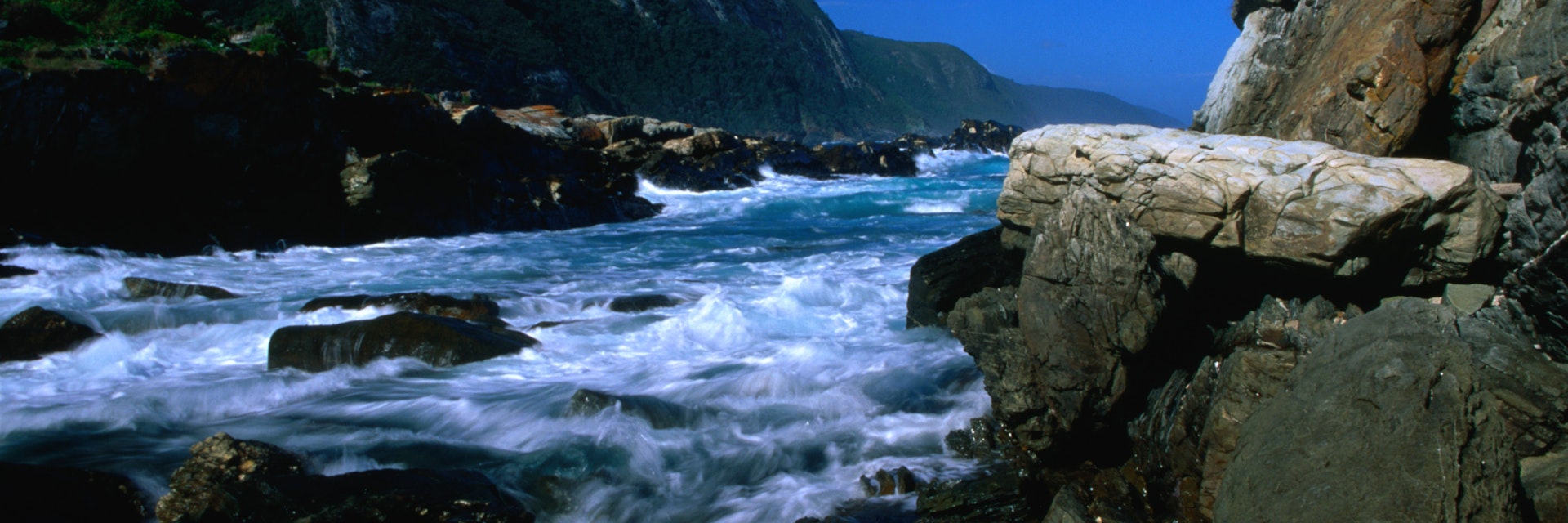
Eastern Cape
From lush tropical forests to uninhabited desert expanses, and from easy-going hammock time to adrenaline-pumping adventures, the Eastern Cape offers a wide range of topography and experiences. Compared with the more developed Western Cape, it can feel like a different country and provides opportunities to learn about Xhosa culture. Some of South Africa's finest hiking (and slackpacking) trails wind along the province's largely undeveloped coastline and through its mountainous, waterfall-filled landscapes.
Leave the planning to a local expert
Experience the real Eastern Cape. Let a local expert handle the planning for you.
Attractions
Must-see attractions.

Valley of Desolation
The park’s most popular sight, the Valley of Desolation is a hauntingly beautiful valley with outstanding views – the rugged, piled dolerite columns are…

Nelson Mandela Museum
The Wild Coast
Set aside at least two hours for this inspiring museum right in the centre. It offers visitors a fascinating journey through the life of Nelson Mandela…
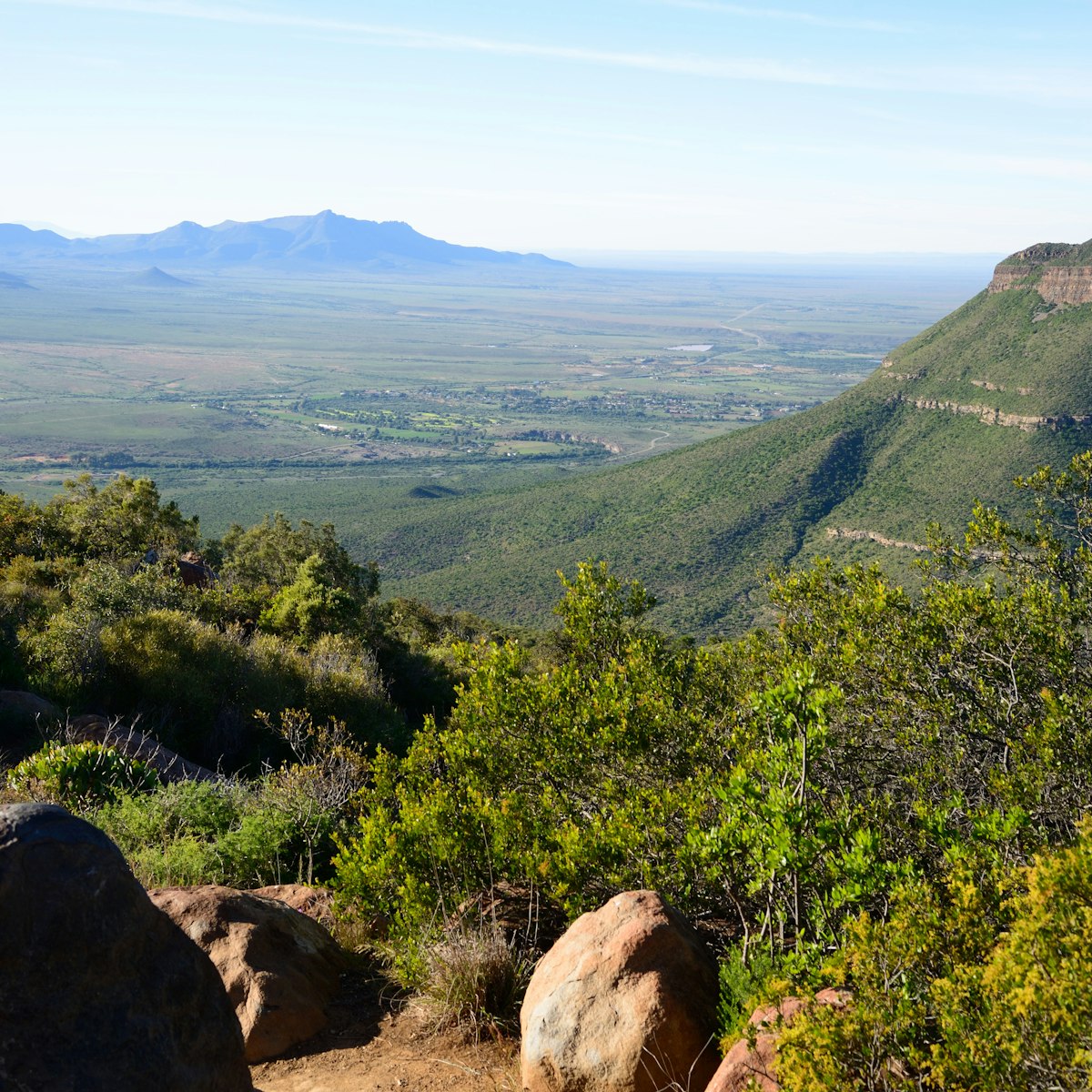
Camdeboo National Park
Camdeboo National Park covers an area of 194 sq km and almost completely surrounds the town of Graaff-Reinet. There are plenty of animals including…

Garden Route National Park (Tsitsikamma Section)
Cut through by dark, coffee-coloured churning rivers, deep ravines and dense forests, the Tsitsikamma section of the Garden Route National Park…
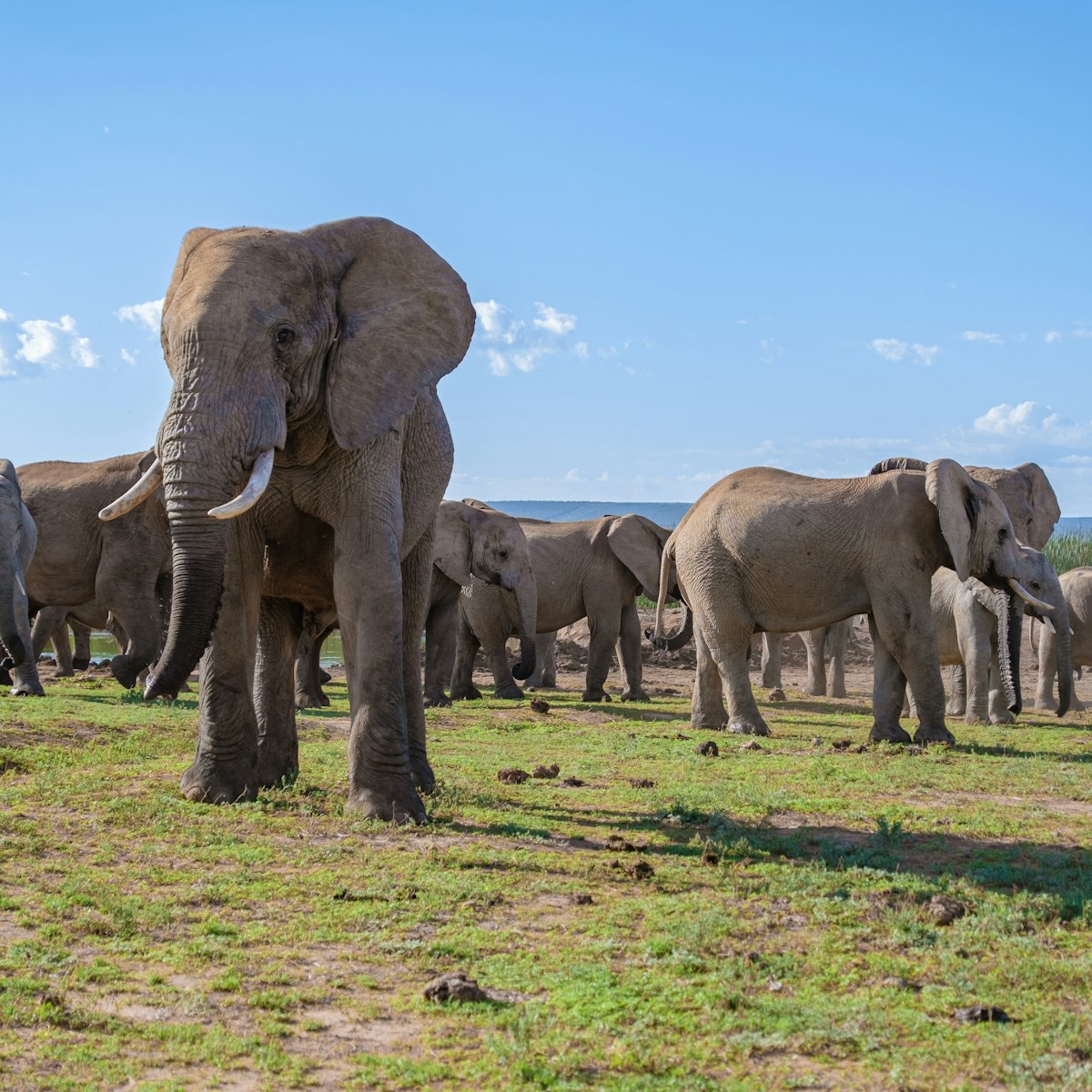
Addo Elephant National Park
Sunshine Coast
Located 70km north of Port Elizabeth, South Africa's third-largest national park protects the remnants of the huge elephant herds that once roamed the…

Hluleka Nature Reserve
Approximately midway between Coffee Bay and Port St Johns, this nature reserve is known for its spectacular coastline of rocky seashores, pristine beaches…

Mountain Zebra National Park
This underrated national park, 12km west of Cradock, is on the northern slopes of the Bankberg Range (2000m), covers 280 sq km and has superb views over…

Schotia Game Reserve
The smallest (and busiest) private reserve in the Addo area, Schotia is contiguous with Addo (accessed from the N10 south of Paterson). Aiming to evoke…
Plan with a local
Experience the real South Africa
Let a local expert craft your dream trip.
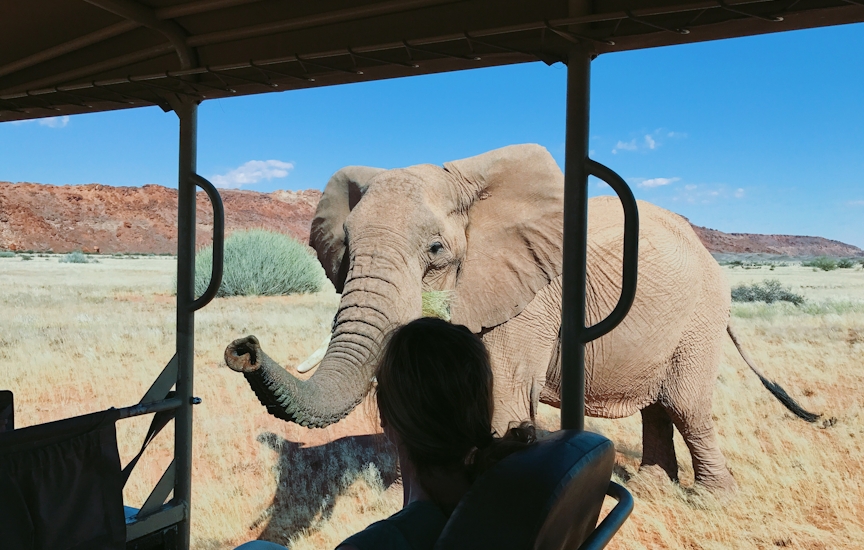
Purchase our award-winning guidebooks
Get to the heart of Eastern Cape with one of our in-depth, award-winning guidebooks, covering maps, itineraries, and expert guidance.
Eastern Cape and beyond
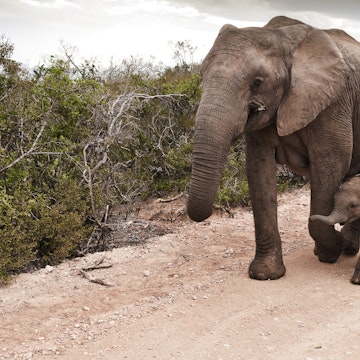

Touropia Travel
Discover the World
15 Best Places to Visit in Eastern Cape
By Alex Schultz · Last updated on April 4, 2024
Boasting beautiful national parks, gorgeous scenery, and a vast swathe of beautiful coastline that hugs the Indian Ocean, the Eastern Cape in South Africa is a delight to explore, with something for everyone to enjoy.
While its natural wonders are certainly what draw many people to South Africa’s second-largest province, its thriving cities and charming villages and towns are equally fascinating places to visit, with its multicultural population speaking Xhosa, English, and Afrikaans, among other languages.
Although Addo National Elephant Park, the Grahamstown National Arts Festival, and the famous surfing destination of Jeffrey’s Bay understandably attract the most visitors, the Eastern Cape has lots of hidden treasures just waiting for you to discover them.
Eastern Cape Map
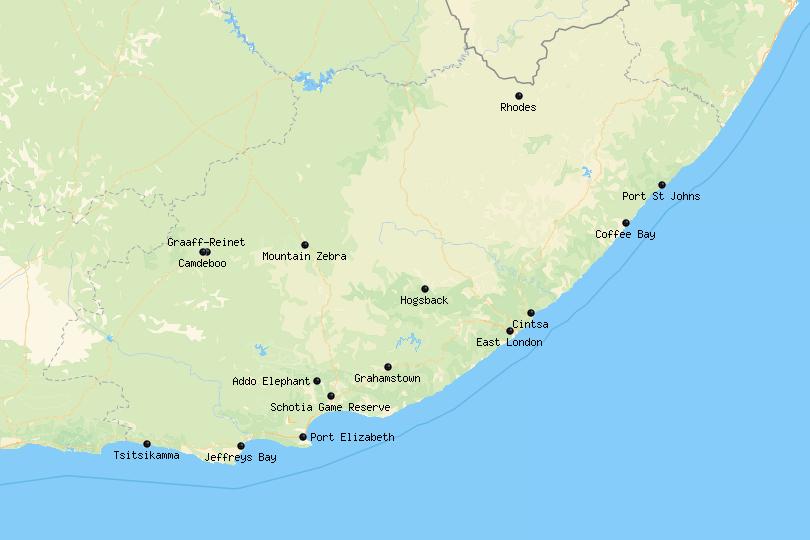
15. Coffee Bay [SEE MAP]
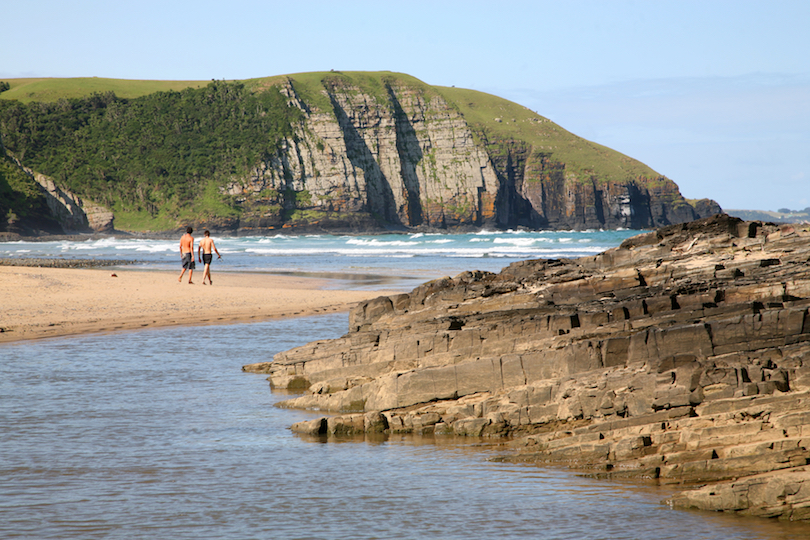
Lying along the appropriately named Wild Coast in the Eastern Cape, Coffee Bay is a wonderful place to visit. Its lovely, sandy beaches are beautifully framed by the rolling verdant hills that lie behind them.
The small, rural Xhosa community is a very peaceful and laidback place to spend some time. Visitors can go hiking in the picturesque natural areas, surfing in the sea’s ample swells, or simply lie on the beach and take in the stunning views.
A must-see when in the area is the distinctive Hole in the Wall, which is dramatically located in the middle of a crumbling cliff jutting out into the ocean.
14. Schotia Game Reserve [SEE MAP]
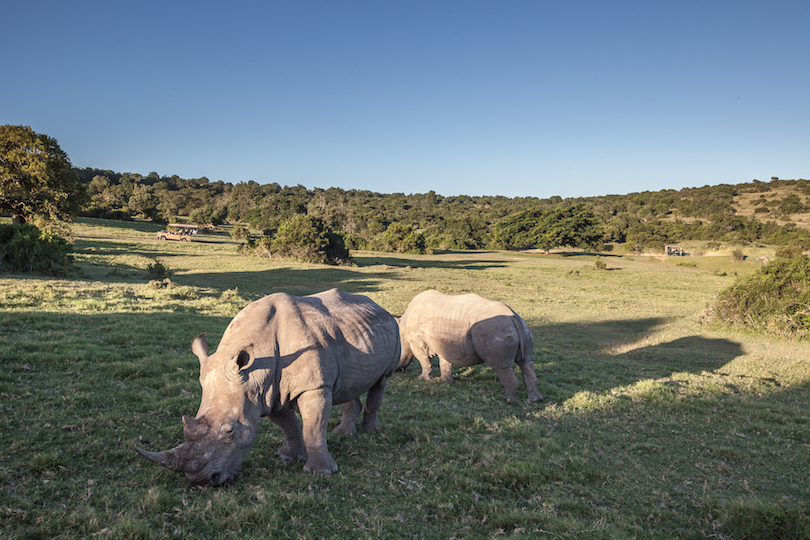
Located just to the east of Addo Elephant National Park, Schotia Game Reserve is a fantastic place to head to if you want to go on a safari. Amongst the two thousand animals in the reserve, you can see lions, rhinos, elephants, and more, up close and personal.
Schotia is the oldest private game reserve in the area, and the landscapes on show are just as breathtakingly beautiful as the animals themselves, with expansive African skies look down on sun-kissed savanna. Staying the night in one of Schotia’s lodges only makes the experience more memorable, as you enjoy a delicious braai while the sun sets over the reserve and the stars come out above.
13. Rhodes [SEE MAP]
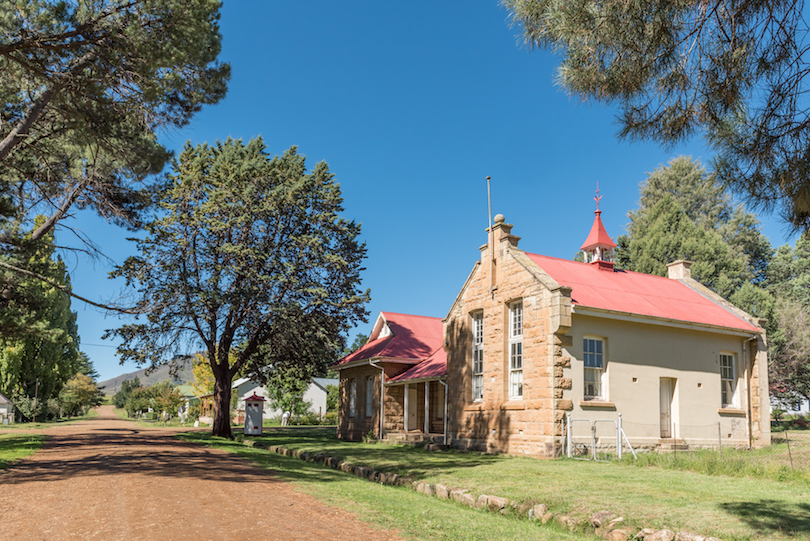
Despite its small size, Rhodes has a lot for you to see and do. Its proximity to the stunning Drakensburg mountain range makes it a great base from which to go hiking or trekking, with the highest mountain in the Cape, Ben Macdhui, also not far away.
Located just 18 kilometers away from the mountain kingdom of Lesotho, Rhodes has a long and interesting history for you to explore. It was invaded numerous times during the Boer War, and legend has it that the village was renamed after the mining magnate Cecil Rhodes in the hope that he would look favorably on its people.
A sleepy, laidback place for most of the year, Rhodes comes alive during the annual Rhodes Trail Run, the Rhodes Mountain Bike Challenge, and the Wild Trout Festival, when crowds of visitors descend upon its streets.
12. Tsitsikamma National Park [SEE MAP]
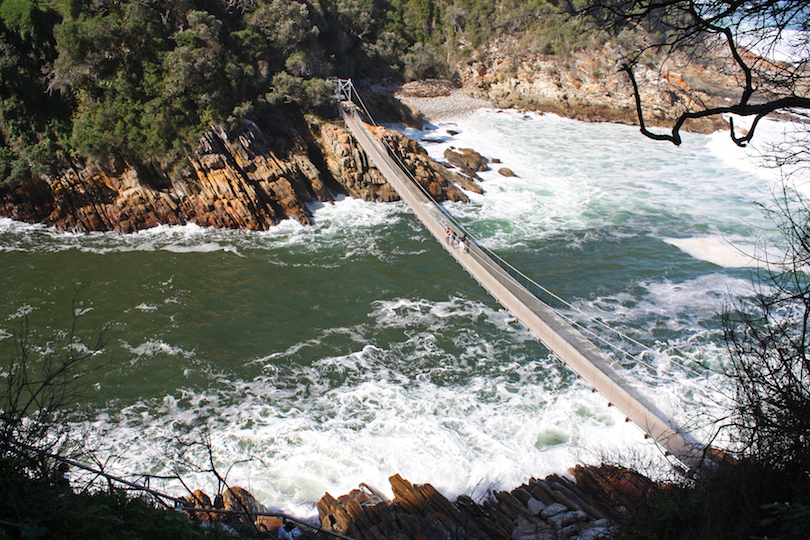
Encompassing scenic coastlines, lush forests, and sparkling rivers winding to the sea, the scenery on show in Tsitsikamma National Park is absolutely stunning. As such, it’s a great place to head to if you want to explore the great outdoors.
With hiking, kayaking, snorkeling, and mountain biking all on offer, this magnificent stretch of the Garden Route National Park will delight nature lovers and outdoor enthusiasts alike.
In addition to hiking along lovely paths such as the gorgeous Otter Trail, visitors can also catch a glimpse of dolphins, porpoise, and whales playing offshore.
With so much fantastic scenery for you to enjoy, and so many activities for you to take part in, Tsitsikamma National Park is not to be missed.
11. Hogsback [SEE MAP]
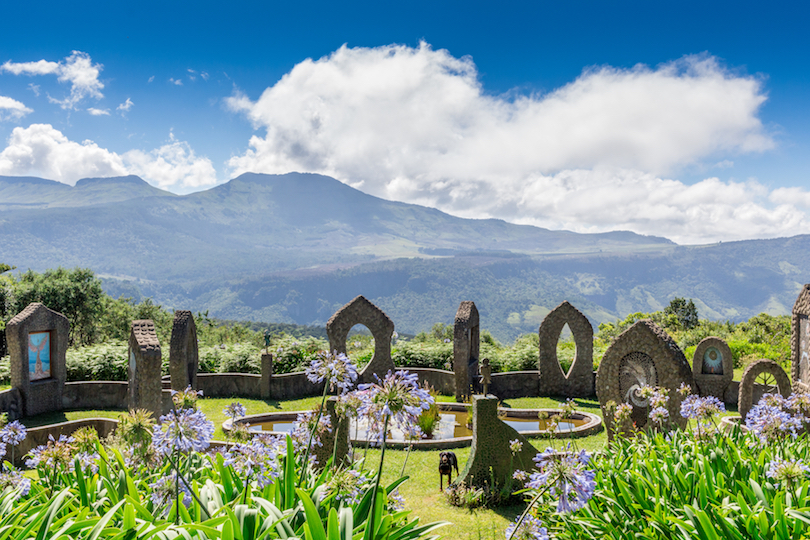
Tucked away high up in the Amathole Mountains with verdant forests all around it, Hogsback is certainly located in an idyllic setting, with three scenic peaks looking out over the peaceful village.
Popular with both local and international tourists, Hogsback is a charming place to visit; its cozy cottages and elegant gardens only add to its charm.
Snaking through the surrounding forests and mountains are a myriad of beautiful hiking trails and paths for you to explore. These take you past glittering waterfalls to viewpoints that offer up fantastic panoramas of the Amathole Mountains.
10. Graaff-Reinet [SEE MAP]
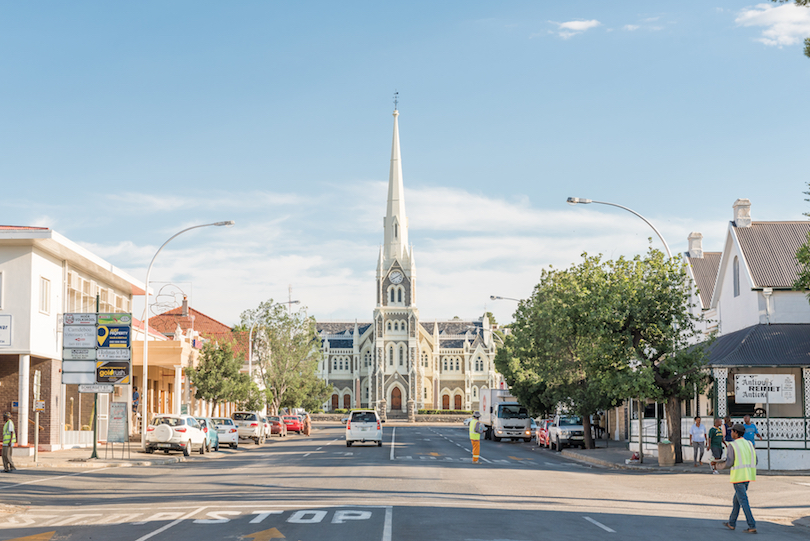
One of the oldest towns in the country, Graaff-Reinet was set up by the Dutch East India Company all the way back in 1786. Due to its long and illustrious history, there are lots of interesting national monuments and cultural landmarks for you to check out.
Surrounded by the beautiful Camdeboo National Park, Graaff-Reinet is bordered by majestic mountains, with lots of farmsteads and game farms scattered around town.
Offering the perfect mix of culture, history, and nature, the town has something for everyone to enjoy, and is particularly ideal for people looking for a quiet getaway.
9. Mountain Zebra National Park [SEE MAP]
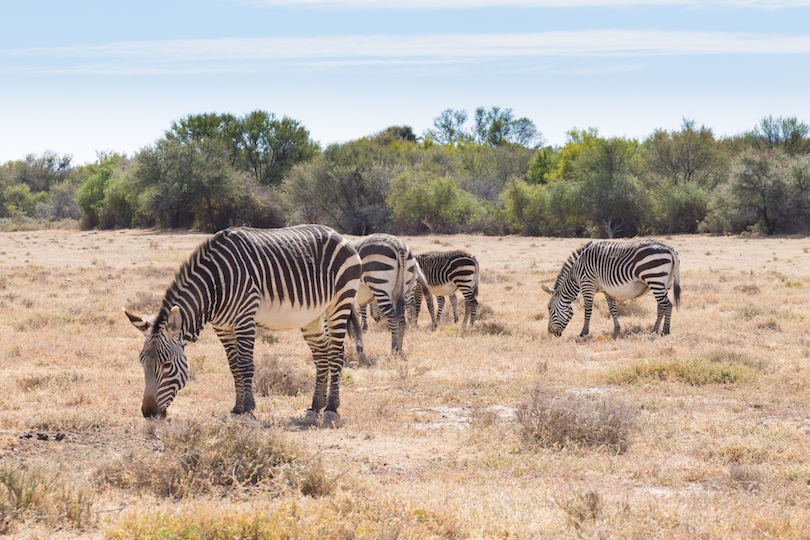
Established in 1937 to protect and preserve the natural habitat of the Cape Mountain zebra, this wonderful national park actually boasts many other species, with lions, cheetahs, buffaloes, and rhinos all found within its confines.
Whether you explore the park’s many paths or roads on foot or by 4X4, you are sure to see the majestic Cape Mountain zebra wherever you go, and the scenery you pass through is always stunning.
Camping or staying in one of the park’s cottages is another fabulous way to experience Mountain Zebra National Park, as the wild and rugged landscapes change completely once the heat of the day fades away and the cool night sets in.
8. Cintsa [SEE MAP]
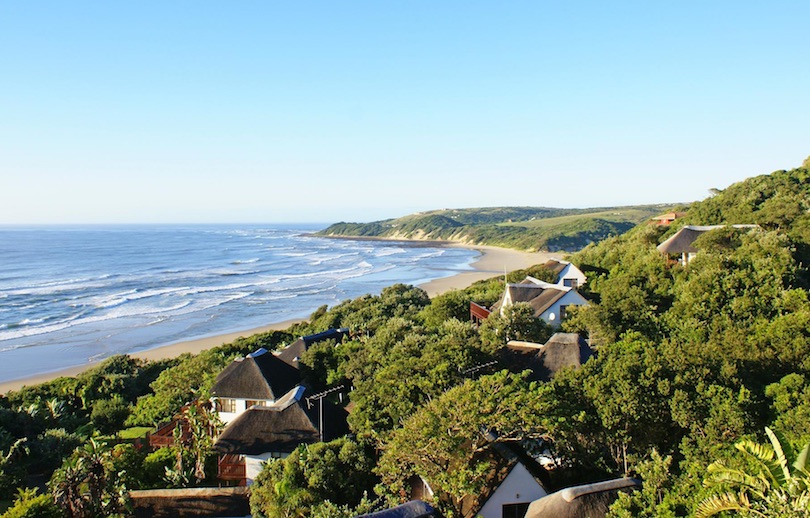
Lying at the mouth of the Cintsa River, the small, sleepy village of the same name is the perfect place to head to if you want to escape the hubbub of nearby East London for a quiet weekend away.
With a lovely, sandy beach running along the coast, which is bordered by lush forests and peacefully rambling hills, the village is set in a beautiful location with lagoons and rivers nearby.
Due to all the beautiful nature on show, Cintsa has lots of fun outdoor activities for you to enjoy; many guests go horseriding along the beach or canoeing and fishing in the gushing rivers. Alternatively, you can simply lounge around on the beach and take in the unspoiled scenery.
7. Port St Johns [SEE MAP]
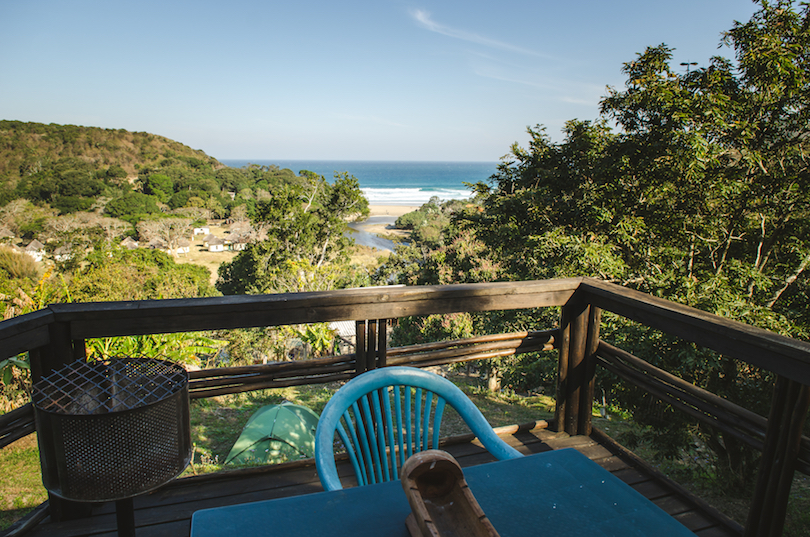
With one of the most dramatic settings in the country, Port St Johns is a treat to visit. Plunging gorges, impenetrable forests, and towering mountains surround the town, while the Umzimvubu River courses right through it and beautiful beaches lie along the coast.
While the town’s natural riches mean many people come here to go hiking, kayaking, fishing, or whale watching, Port St Johns’ vibrant feel and multicultural identity are just as alluring to many others.
Set in Xhosa country with Afrikaans and English also used around town, crumbling buildings dating back to colonial times hint at its diverse heritage, while the lively yet laidback vibe has long attracted both backpackers and hippies alike.
With the Wild Coast’s breathtaking natural sights just a short walk away, Port St Johns is well worth visiting if you have the chance.
6. East London [SEE MAP]
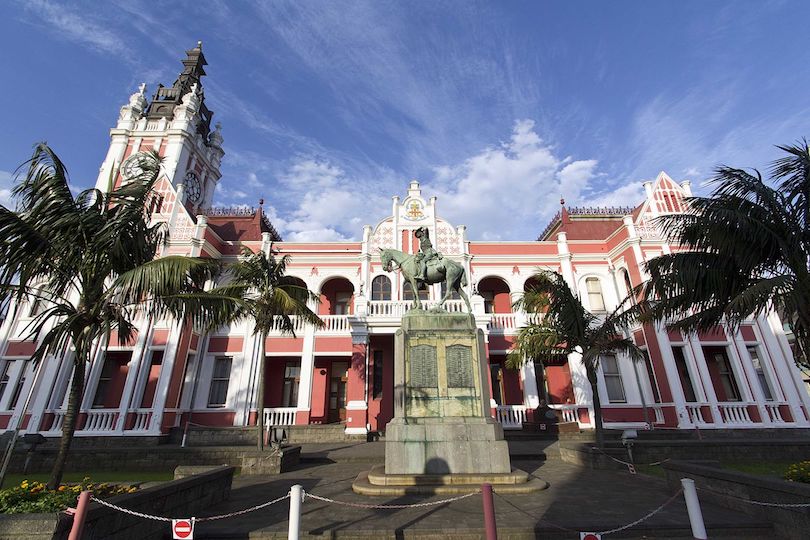
Lying on the southeast coast of the country, East London is the second-largest city in the Eastern Cape and the only river port in South Africa. As it lies on the Sunshine Coast, which is blessed with untouched and unspoiled beaches, the city is a popular tourist destination with both locals and foreigners alike, who flock to its shores to enjoy its golden sands.
Consequently, it has all the amenities that you would expect of a city its size, with lots of great restaurants, bars, and hotels all on offer.
If you want to gain a great understanding and appreciation for the region’s ancient history, head to the East London Museum to learn all about the Khoisan people who used to live here and the Xhosa-British battles that took place in the 19th century Frontier Wars.
5. Camdeboo National Park [SEE MAP]
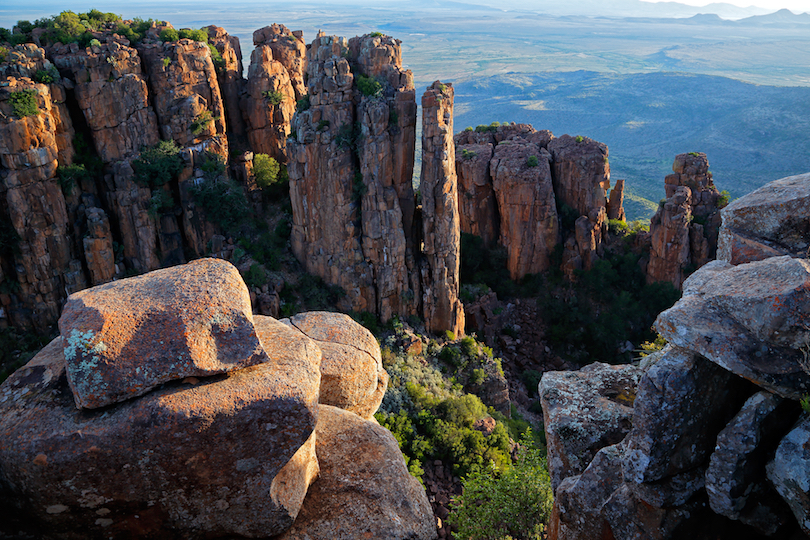
With incredible and impressively named places such as the Valley of Desolation and the Cathedral of Mountains for you to check out, you really don’t want to pass up on the opportunity of visiting Camdeboo National Park.
While the landscapes and views on offer are simply jaw-dropping, there is a wealth of activities for you to try out, such as mountain biking and hiking, while windsurfing and canoeing at Nqweba Dam are also great fun.
In addition to all this, visitors can also enjoy birdwatching or game viewing, with buffalo, springbok, and wildebeest all residing within the park. The undoubted highlight, however, is the great Karoo plains, which are dramatically overlooked by crumbling, jagged rock formations.
4. Grahamstown [SEE MAP]
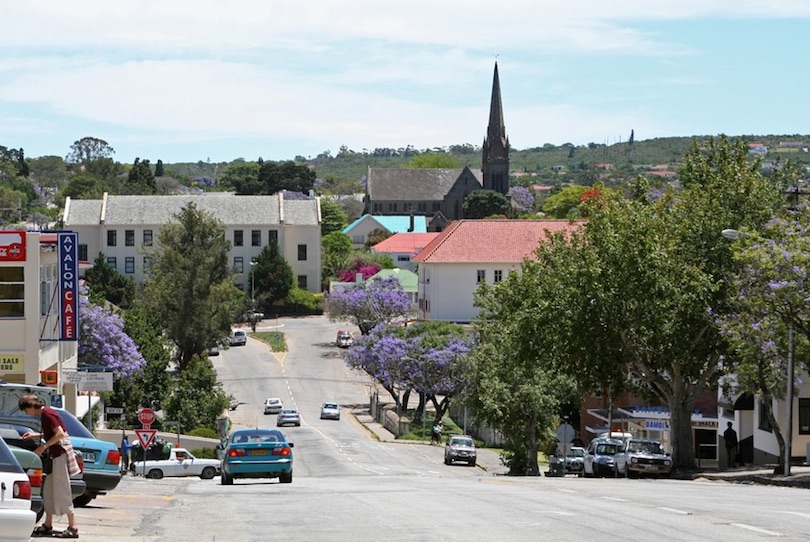
While many people still know the town as Grahamstown, the official name was changed in June 2018 to Makhanda, after a legendary Xhosa warrior and prophet. This name change emphasizes the town’s at times turbulent and troubled past; it was once at the forefront of battles between British settlers and the Xhosa during the Frontier Wars.
Nowadays, there is a vibrant feel to the multicultural town, with a number of interesting museums on offer. Each year, both the National Arts Festival – the largest arts celebration on the continent – and SciFest Africa attract crowds of visitors to Makhanda.
On top of all this, the town is just a short drive away from some very scenic coastline, while nature reserves where you can view the Big Five are also not too far away.
3. Port Elizabeth [SEE MAP]
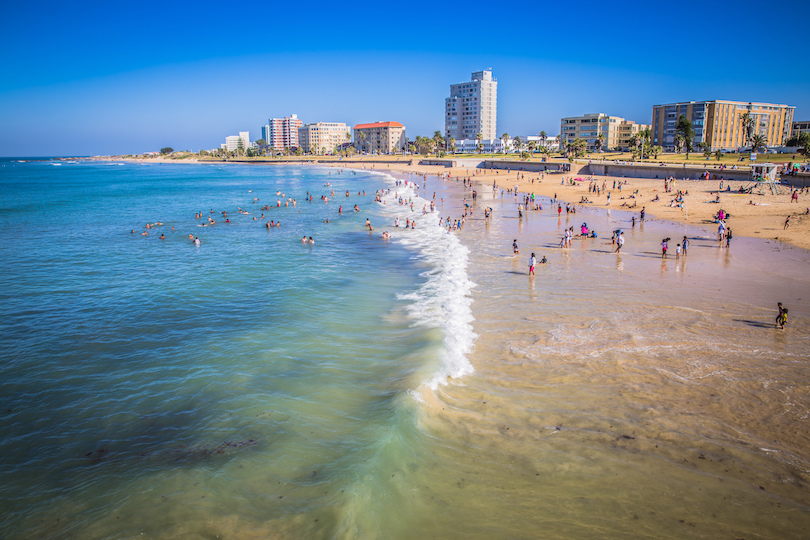
Often nicknamed PE – or ‘the Windy City’ – Port Elizabeth is one of the largest cities in South Africa. It lies at one end of the Garden Route on the scenic Sunshine Coast. As well as boasting many beautiful beaches, PE also has several great surf spots for you to check out, in addition to lots of other fun watersports.
In recent years, the center of town has been spruced up; now you can find some great restaurants and bars that perfectly complement its vibrant multicultural feel and identity.
With Addo Elephant National Park lying nearby, and whale and dolphin watching offshore, Port Elizabeth certainly has something for everyone to enjoy.
2. Jeffreys Bay [SEE MAP]
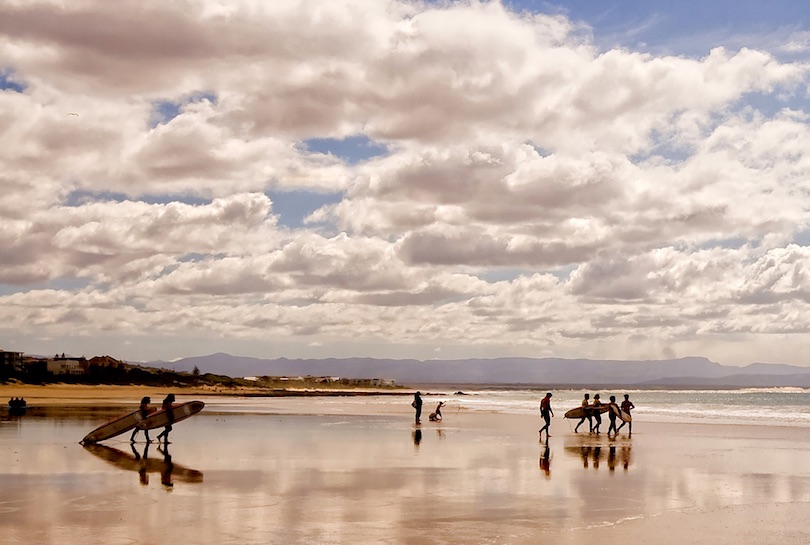
One of the most famous surfing destinations in the world, Jeffrey’s Bay attracts surfers from all around the globe, who descend upon the town to try out the challenging Jeffrey’s Bay Surf Break. Due to all the surfers who hang out along its beautiful beach, the town has a very laidback vibe, with lots of coffee shops and beachside restaurants and cafes on offer.
While the surf, sea, and sunshine are what most people come for, Jeffrey’s Bay is bordered by some beautiful nature reserves. The two rivers that lie to either side of it have plenty of great hikes for you to check out, with some fantastic birdwatching to boot.
1. Addo Elephant National Park [SEE MAP]
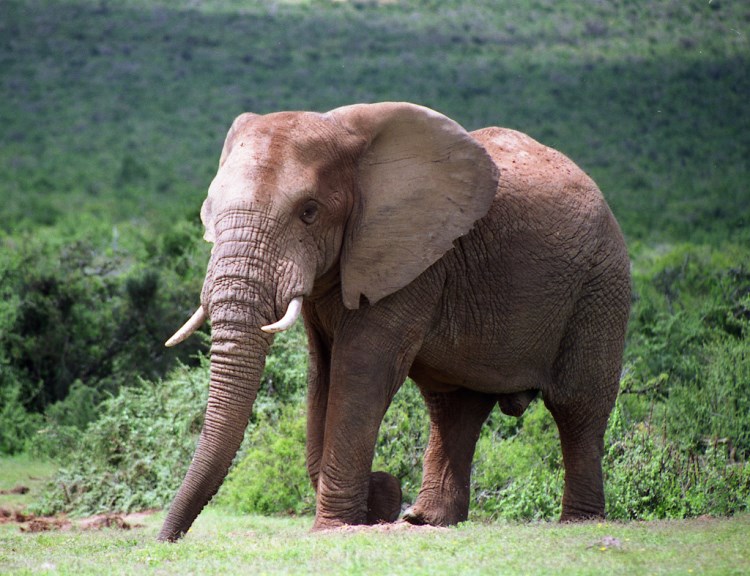
Located just a short distance from Port Elizabeth, Addo Elephant National Park is the third-largest national park in the country, and within its confines you can find a wide range of different landscapes, animals, fauna, and flora. With over 600 elephants, alongside lions, buffalo, leopards, and more, it is a fantastic place to spot these majestic mammals up close in their natural habitat.
As well as camping and staying the night in the park, guests can also go hiking or mountain biking through the glorious Zuurberg Mountains, or stroll along the sandy dunes that lie in its coastal regions. A very popular place to visit, and with good reason too, Addo Elephant National Park is certainly the crown jewel of what the Eastern Cape has to offer.
Share this post:
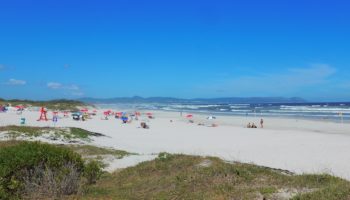
10 Best Beaches in South Africa
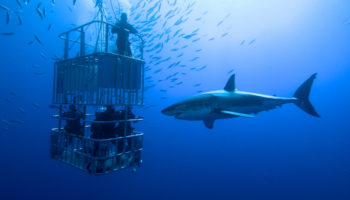
7 Best Day Trips from Cape Town
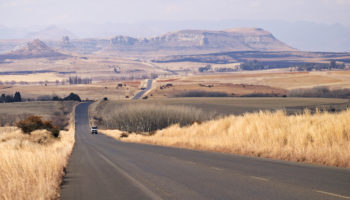
9 Most Beautiful Regions in South Africa
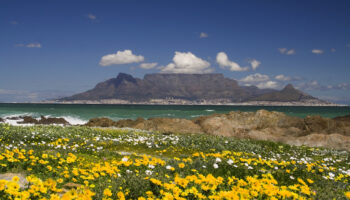
Best Time to Visit Cape Town: Month-by-Month Guide
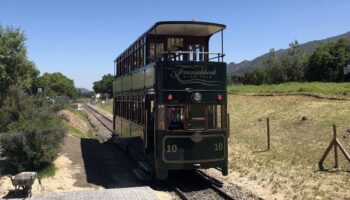
All Aboard the Franschhoek Wine Tram
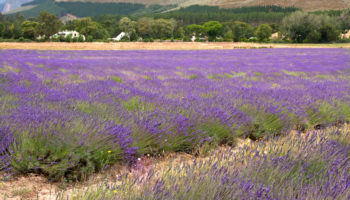
15 Best Places to Visit in Western Cape
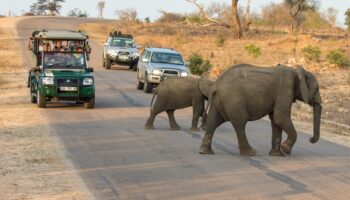

A Beginner’s Guide to Kruger National Park: Discover the Big 5
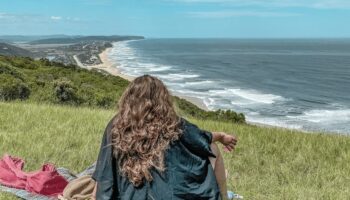
The 7 Best Things To Do On The Garden Route in South Africa
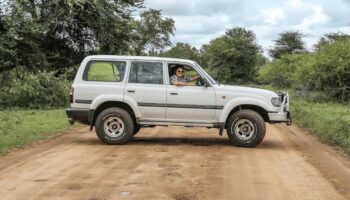
6 Must Do Experiences in Mpumalanga, South Africa
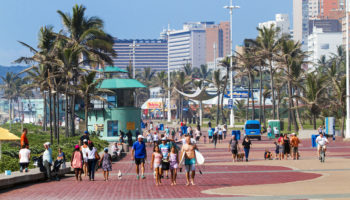
15 Best Cities to Visit in South Africa
The Eastern Cape Travel Guide
Book your individual trip , stress-free with local travel experts
- roughguides.com
- South Africa
- the-eastern-cape
- Travel guide
- Itineraries
- Local Experts
- Travel Advice
- Accommodation
Plan your tailor-made trip with a local expert
Book securely with money-back guarantee
Travel stress-free with local assistance and 24/7 support
Julian De Silva
The team put together an excellent… The team put together an excellent itinerary and trip for us to South Africa. It was exceptionally good from drivers, ...
Sandwiched between the Western Cape and KwaZulu-Natal, South Africa’s two most popular coastal provinces, the Eastern Cape tends to be bypassed by visitors – and for all the wrong reasons. The relative neglect it has suffered as a tourist destination and at the hands of the government is precisely where its charm lies. You can still find traditional African villages here, and the region’s 1000km of undeveloped coastline alone justifies a visit, sweeping back inland in immense undulations of vegetated dunefields. For anyone wanting to get off the beaten track, the province is, in fact, one of the most rewarding regions in South Africa.
Brief history of the Eastern Cape
Port elizabeth and the western region, the central eastern cape and east london, the eastern cape drakensberg, the wild coast region, addo elephant national park, east london, grahamstown, the grahamstown festival, port elizabeth, port st johns, qunu and the nelson mandela youth and heritage centre, nelson mandela and the qunu connection.
Port Elizabeth is the province’s commercial centre, principally used to start or end a trip along the Garden Route, though it’s a useful springboard for launching out into the rest of South Africa – the city is the transport hub of the Eastern Cape. Jeffrey’s Bay, 75km to the west, has a fabled reputation among surfers for its perfect waves. Around an hour’s drive inland are some of the province’s most significant game reserves, among them Addo Elephant National Park , a Big Five reserve where sightings of elephants are virtually guaranteed. Addo and the private reserves nearby are among the few game reserves in South Africa that are malaria-free throughout the year. The hinterland to the north takes in areas appropriated by English immigrants shipped out in the 1820s as ballast for a new British colony. Here, Grahamstown glories in its twin roles as the spiritual home of English-speaking South Africa and host to Africa’s biggest arts festival.
The northwest is dominated by the sparse beauty of the Karoo, the thorny semi-desert stretching across much of central South Africa. The rugged Mountain Zebra National Park, 200km north of Port Elizabeth , is a stirring landscape of flat-topped mountains and arid plains stretching for hundreds of kilometres. A short step to the west, Graaff-Reinet is the quintessential eighteenth-century Cape Dutch Karoo town.
The eastern part of the province, largely the former Transkei, is by far the least developed, with rural Xhosa villages predominating. East London , the province’s only other centre of any size, serves well as a springboard for heading into the Transkei, where the principal interest derives from political and cultural connections. Steve Biko was born here, and you can visit his grave in King William’s Town to the west. Further west is Fort Hare University, which educated many contemporary African leaders. The only established resorts in this section are in the Amatola Mountains, notably Hogsback, where indigenous forests and mossy coolness provide relief from the dry scrublands below.
Tucked into the northeastern corner of the province, the Drakensberg range, more commonly associated with KwaZulu-Natal, makes a steep ascent out of the Karoo and offers trout-fishing and ancient San rock art. The focus of the area is the remote, lovely village of Rhodes. Further east, the Wild Coast region remains one of the least developed and most exciting regions in the country. The poorest part of the poorest province, the region is blessed with fabulously beautiful subtropical coast. From here, all the way to the KwaZulu-Natal border, dirt roads trundle down to the coast from the N2 to dozens of remote and indolent hillside resorts, of which Port St Johns is the biggest and best known. In the rugged, goat-chewed landscape inland, Xhosa-speakers live in mud-and-tin homesteads, scraping a living herding stock and growing crops. Most visitors pass as quickly as possible through Mthatha (formerly Umtata), the ugly former capital of the Transkei – but if you’re following in the footsteps of Nelson Mandela, the Nelson Mandela Museum in the centre of Mthatha, and Qunu, his birthplace southwest of the town, are obvious ports of call.
Tailor-made travel itineraries for South Africa, created by local experts
_listing_1637090645279.jpeg)
7 days / from 4800 USD
Cape Town and Garden Route - a luxury guided tour
Cape Town and the Garden Route have it all - a fascinating culture, safaris, chocolate and wine tasting, and much more. Discover the coastal city of Cape Town and the Peninsula before heading out to the Garden Route with Knysna and Mossel Bay, where you'll experience some game drives.

15 days / from 4000 USD
The Cape Peninsula and Safaris in Kruger and Pilanesberg
Wildlife in South Africa is still truly wild, a fact that you'll be able to discover in this fascinating two weeks trip. Enjoy whale watching in Cape Town and first safaris in Aquila before heading up north: the famous Kruger and Pilanesberg national parks with all its wildlife await.
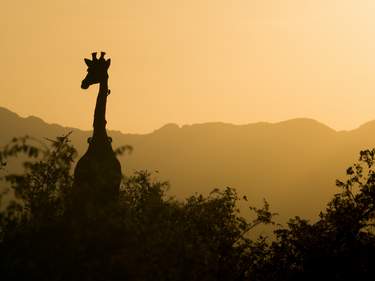
7 days / from 3000 USD
Explore the North of South Africa: Sun City and Madikwe game reserve
For those short on time, staying close to Johannesburg may make sense. On this trip, you'll arrive and depart in Johannesburg and then transfer to the theme park Lost City before continuing to Madikwe for a few days of game drives to spot plenty of wildlife.
The Eastern Cape was carved up into black and white territories under apartheid in a more consolidated way than anywhere else in the country. The stark contrasts between wealth and poverty were forged in the nineteenth century when the British drew the Cape colonial frontier along the Great Fish River, a thousand kilometres east of Cape Town, and fought over half a dozen campaigns (known as the Frontier Wars) to keep the Xhosa at bay on its east bank. In the 1820s, the British shipped in thousands of settlers to bolster white numbers and reinforce the line.
Even for a country where everything is suffused with politics, the Eastern Cape’s identity is excessively political. South Africa’s black trade unions have deep roots in its soil, which also produced many anti-apartheid African leaders, including former president Nelson Mandela, his successor Thabo Mbeki, and Black Consciousness leader Steve Biko, who died in 1977 at the hands of Port Elizabeth security police. The Transkei or Wild Coast region, wedged between the Kei and KwaZulu-Natal, was the testing ground for grand apartheid when it became the prototype in 1963 for the Bantustan system of racial segregation. In 1976 the South African government gave it notional “independence”, in the hope that several million Xhosa-speaking South Africans, surplus to industry’s needs, could be dumped in the territory and thereby become foreigners in “white South Africa”. When the Transkei was reincorporated into South Africa in 1994 it became part of the new Eastern Cape, a province struggling for economic survival under the weight of its apartheid-era legacy and the added burden of widespread corruption.
Port Elizabeth is the industrial centre of the Eastern Cape. In 1820 it was the arrival point for four thousand British settlers, who doubled the English-speaking population of South Africa and have left their trace on the architecture in the town centre. The port’s industrial feel is mitigated by some outstanding city beaches and, should you end up killing time here, you’ll find diversion in beautiful coastal walks a few kilometres from town and in the small historical centre.
However, the main reason most people wash up here is to start or finish a tour of the Garden Route – or head further up the highway to Addo Elephant National Park , the most significant game reserve in the southern half of the country. Also within easy striking distance are several other smaller, and utterly luxurious, private game reserves.
East of Port Elizabeth , a handful of resorts punctuate the R72 East London coast road, where the roaring surf meets enormously wide sandy beaches, backed by mountainous dunes. The inland route to East London deviates away from the coast to pass through Grahamstown , a handsome university town, worth at least a night, and several during the National Arts Festival every July.
A couple of hundred kilometres north from Port Elizabeth , an area of flat-topped hills and treeless plains opens out to the Karoo, the semi-desert that extends across a third of South Africa. The oldest and best known of the settlements here is the picture-postcard town of Graaff-Reinet, a solid fixture on bus tours. Just a few kilometres away is the awesome Valley of Desolation, and the village of Nieu Bethesda, best known for its eccentric Owl House museum. Nearly as pretty as Graaff-Reinet, though not as architecturally rich, the town of Cradock, to its east, has the added attraction of the rugged Mountain Zebra National Park.
Jeffrey's Bay
Some 75km west of Port Elizabeth , off the N2, JEFFREY’S BAY (known locally as J Bay) is jammed during the holiday seasons, when thousands of visitors throng the beaches, surfing shops and fast-food outlets, giving the place a really tacky seaside resort feel.
For surfing aficionados, however, this is a trifling detail; J Bay is said by some to be one of the world’s top three surfing spots. If you’ve come to surf, head for the break at Super Tubes, east of the main bathing beach, which produces an impressive and consistent swirling tube of whitewater, attracting surfers from all over the world throughout the year. Riding inside the vortex of a wave is considered the ultimate experience by surf buffs, but should only be attempted if you’re an expert. Other key spots are at Kitchen Windows, Magna Tubes, the Point and Albatross. Surfing gear, including wet suits, can be rented from the multitude of surfing shops along Da Gama Road.
Dolphins regularly surf the waves here, and whales can sometimes be seen between June and October. The main bathing areas are Main Beach (in town) and Kabeljous-on-Sea (a few kilometres north), with some wonderful seashells to be found between Main and Surfer’s Point.
The Eastern Cape Karoo
Travelling between Grahamstown and the towns of Cradock and Graaff-Reinet (the Eastern Cape’s two most-visited Karoo towns), you’ll be heading into sheep-farming country, with the occasional dorp rising against the horizon, offering the experience of an archetypal Eastern Cape one-horse outpost. The roads through this vast emptiness are quiet, and lined with rhythmically spaced telephone poles. Dun-coloured sheep, angora goats and the occasional springbok graze on brown stubble, and you’ll often see groups of charcoal-and-grey ostriches in the veld. Staying on a farm in this region is a highlight.
Cradock, 240km north of Port Elizabeth , lies in the Karoo proper, and makes a great stopover on the Port Elizabeth to Johannesburg run, because of its excellent accommodation and its proximity to the beautiful Mountain Zebra National Park. Some 100km due west of Cradock, Graaff-Reinet is one of the oldest towns in South Africa, and much of its historical centre is intact. Surrounding the town is the Camdeboo National Park. For more of a sense of the Karoo’s dry timelessness, head to Nieu Bethesda, 50km to the north of town.
Mountain Zebra National Park
When the Mountain Zebra National Park was created in 1937, there were only five Cape mountain zebras left on its 65 square kilometres – and four were male. Miraculously, conservationists managed to cobble together a breeding herd from the few survivors on surrounding farms, and the park now supports several hundred.
For game viewing, the park has a couple of good part-tar, part-gravel loop roads forming a rough figure of eight. As well as zebra, keep an eye out for springbok, blesbok and black wildebeest. The introduction of buffalo in 1998 and plans to bring in cheetahs and rhinos add to the wildlife interest, but mean that hiking across the park isn’t possible, since buffalo have a reputation for extreme aggression. There are, however, two waymarked walks near the camp.
Graaff-Reinet
It’s little wonder that tour buses pull in to GRAAFF-REINET in their numbers; this is a beautiful town and one of the few places in the Eastern Cape where you’d want to wander freely day and night, taking in historical buildings and the occasional little museum, and having a meal or a drink before strolling back to your accommodation.
Graaff-Reinet has a large population of Afrikaans-speaking coloured people, mostly living on the south side of town, some of slave origin, others the descendants of indigenous Khoi and San who were forced to work on frontier farms. The dry mountains surrounding the town are part of the Camdeboo National Park whose main attraction is the Valley of Desolation, a B-movie name for an impressive site. The rocky canyon, echoing bird calls and expansive skies of the valley shouldn’t be missed.
Robert Sobukwe and the Africanists
One of Graaff-Reinet’s most brilliant but often-forgotten sons is Robert Managaliso Sobukwe, founder of the Pan Africanist Congress (PAC). Born in 1923, Sobukwe went to Healdtown, a boarding school, then Fort Hare University, where he joined the African National Congress Youth League. After graduating in 1947, he became a schoolteacher and then a lecturer at the University of the Witwatersrand. A charismatic member of the Africanist wing of the ANC – even the ultra-apartheid prime minister B.J. Vorster acknowledged him as "a man of magnetic personality" – Sobukwe questioned the organization’s strategy of cooperating with whites, and formed the breakaway PAC in 1959. The following year he launched the nationwide anti-pass protests, which ended in the Sharpeville massacre and his imprisonment on Robben Island for nine years. In 1969, Sobukwe was released under a banning order to Kimberley, where he died in 1978. Five thousand people attended his funeral in Graaff-Reinet.
Between Port Alfred and East London lies some of the Eastern Cape’s least-developed coastline, although it has now fallen into the hands of developers as more and more people discover the beauty of the region. East London , wedged uncomfortably between two ex-Bantustans, is the largest city in the central region of the province, with excellent beaches for surfing and swimming and good transport links to Johannesburg and along the coast. Inland, Fort Hare University near Alice has educated political leaders across the subcontinent, including Nelson Mandela, and has the country’s finest collection of contemporary black South African art.
Sweeping up from Fort Hare’s valley, the gentle, wooded Amatola Mountains yield to the dramatic landscapes of the Eastern Cape Drakensberg, which offer hiking, horseriding and even skiing opportunities. Before white settlers (or even the Xhosa) arrived, these towering formations were dominated by San hunter-gatherers, who decorated the rock faces with thousands of ritual paintings, many of which remain surprisingly vivid.
The Amatola Mountains
Most visitors drive quickly through the scrubby, dry, impoverished area between East London and the Amatola Mountains proper, to reach the cool forests and holiday lands at Hogsback. However, it’s worth deviating en route, to see the fine collection of African art at Fort Hare University, close to the little town of Alice, and to take in some peeling, but intact, colonial streetscapes in King William’s Town.
Steve Biko and Black Consciousness
Steve Biko’s brutal interrogation and death while in police custody triggered international outrage and turned opinion further against the apartheid regime.
Steven Bantu Biko was born in 1946 in King William’s Town. His political ascent was swift, due to his eloquence, charisma and focused vision. While still a medical student at Natal University during the late 1960s, he was elected president of the exclusively black South African Students’ Organization (SASO) and started publishing articles in their journal, fiercely attacking white liberalism, which they saw as patronizing and counter-revolutionary. In an atmosphere of repression, Biko’s brand of Black Consciousness immediately caught on. He called for blacks to take destiny into their own hands, to unify and rid themselves of the "shackles that bind them to perpetual servitude". From 1973 onwards, Biko suffered banning, detention and other harassment at the hands of the state. In 1974, he defended himself in court, presenting his case so brilliantly that his international profile soared.
Barred from leaving King William’s Town, Biko continued working and writing, frequently escaping his confinement. In August 1977 he was detained and taken to Port Elizabeth where he was interrogated and tortured. A month later he died from a brain haemorrhage, after a beating by security police. No one was held accountable. He is buried in King William’s Town. The polished, charcoal-coloured tombstone sits midway through the graveyard, among the large patch of paupers’ graves. To get there, take Cathcart Street south out of town (towards Grahamstown ), turning left onto a road signposted to the cemetery, after the bridge (just before the Alice turn-off to the right).
Fort Hare University
Despite decades of deliberate neglect, and its relegation after 1959 to a "tribal" university under apartheid, Fort Hare, 2km east of Alice on the R63, is assured a place in South African history. Established in 1916 as a multiracial college by missionaries, it became the first institution in South Africa to deliver tertiary education to blacks, and was attended by many prominent African leaders, including Zimbabwe’s president Robert Mugabe and Tanzania’s former president, Julius Nyerere. The most famous former student is Nelson Mandela, making this an essential port of call if you’re following his footsteps.
If you have even the slightest interest in African art, Fort Hare’s De Beers Art Gallery is well worth a visit. A treasury of contemporary black Southern African art, it’s one of the most significant and least publicized collections anywhere. The gallery also houses Fort Hare’s ethnographic collection – a major museum of traditional crafts and artefacts, with many rare and valuable pieces.
The Eastern Cape Drakensberg is the most southerly section of Southern Africa’s highest and most extensive mountain chain, stretching east across Lesotho and up the west flank of KwaZulu-Natal into Mpumalanga. The obvious goal of this world of San rock paintings, sandstone caves and craggy sheep farms is Rhodes, one of the country’s best-preserved and prettiest Victorian villages. Since there is no national park in the Eastern Cape Drakensberg, activities are all arranged through private farms. Very remote, Rhodes is reached from Barkly East, which itself is 130km from Aliwal North on the N6. The 60km dirt road to Rhodes from Barkly East is tortuous and rough, taking a good ninety minutes, with sheer, unfenced drops.
RHODES is almost too good to be true – a remote and beautiful village girdled by the Eastern Cape Drakensberg. Few people actually live here: like other villages in this region, Rhodes was progressively deserted as residents gravitated to the cities to make a living, leaving its Victorian tin-roofed architecture stuck in a very pleasing time warp. Today, its raison d’être is as a low-key holiday place for people who appreciate its isolation, wood stoves and restored cottages. Although electricity reached the village a few years ago, very few establishments have it, and paraffin lamps and candles are the norm. Given that Rhodes is not on the way to anywhere (on some maps it doesn’t even appear), it is a place to dwell for a few days, rather than for an overnight stop. While nights are cool even in summer, in winter they are freezing, and there’s no central heating, so pack warm clothes.
The village itself is not much more than a few crisscrossing gravel roads lined with pine trees. At the heart of the village is the Rhodes Hotel, a general shop and a garage; there’s also a post office and payphone, but no banking facilities and no public transport in or out of the village.
Rhodes used to be busy in the winter, when skiers used it as a base for the artificial snowed Tiffendell slopes, but this activity has ceased due to mysterious legalities. The village is an hour’s 4WD drive into the highest peaks of the Eastern Cape Drakensberg. December to May are the best months for swimming and hiking.
The Wild Coast region is aptly named: this is one of South Africa’s most unspoilt areas, a vast stretch of undulating hills, lush forest and spectacular beaches skirting a section of the Indian Ocean. Its undeveloped sandy beaches stretch for hundreds of kilometres, punctuated by rivers and several wonderful, reasonably priced hotels geared to family seaside holidays. The wildness goes beyond the landscape, for this is the former Transkei homeland, a desperately poor region that was disenfranchised during apartheid and turned into a dumping ground for Africans too old or too young for South African industry to make use of.
The Wild Coast region’s inhabitants are predominantly Xhosa, and those in rural areas live mostly in traditional rondavels dotting the landscape for as far as the eye can see. The N2 highway runs through the middle of the region, passing through the old Transkei capital of Mthatha and a host of scruffy, busy little towns along the way. To the south of the highway, the coastal region stretches from just north of East London to the mouth of the Mtamvuna River. With its succession of great beaches, hidden reefs, patches of subtropical forest, rural Xhosa settlements and the attractive little towns of Coffee Bay and Port St Johns (both popular with backpackers), this region offers the most deserted and undeveloped beaches in the country.
The Wild Coast, unlike the Western Cape Garden Route, is not a stretch that you can easily tour by car. There’s no coastal road, and no direct route between one seaside resort and the next. Yet in this remoteness lies the region’s charm. Resorts are isolated down long, winding gravel roads off the N2, which sticks to the high inland plateau. Choose one or two places to stay, and stay put for a relaxing few days. Most places along this stretch of coast are known simply by the name of the hotel that nominates the settlement, though you will also see the Xhosa name of the river mouth, on which each hotel is situated, on many maps.
Straddling the Mthatha River and the N2 highway 235km from East London , the fractious, shambolic town of MTHATHA (formerly Umtata) is the erstwhile capital of the Transkei and the Wild Coast region’s largest town. Unfortunately, it’s a pretty ugly place, its crowded and litter-strewn streets lined with nondescript 1970s office buildings, with the odd older architectural gem, albeit dilapidated. However, the town is useful for stocking up and drawing money, all of which can be done at the Spar Centre or Shell Ultra City on the edge of town. The only reason to venture into the town centre is to visit the Nelson Mandela Museum, housed in the old parliament, or bungha, built in 1927. The most interesting display in the museum traces the great man’s life with photos and other visual material. The museum co-ordinates guided trips to Qunu and Mveso, Mandela’s birthplace, from its sister museum, the Youth and Heritage Centre in Qunu .
Some Xhosa traditions
The Wild Coast region is largely populated by rural Xhosa, who still practise traditions and customs that have faded in more urban areas. Many people, for example, still believe that the sea is inhabited by strange people who do not always welcome visitors, which explains the relative scarcity of the activities you would normally find thriving among seashore-dwelling people, such as fishing and diving.
Initiation for teenage boys and young men is still common. Young men usually leave their homes to stay in "circumcision lodges", dress in distinctive white paint and costumes and learn the customs of their clan. At the circumcision ceremony the young men are expected to make no sound while their foreskin is cut off (with no anaesthetic). After the ceremony, they wash off the paint and wrap themselves in new blankets, and all their possessions are thrown into a hut and set alight – they must turn away from this and not look back. There follows a feast to celebrate the beginning of manhood and the start of a year-long intermediary period during which they wear ochre-coloured clay on their faces. After this, they are counted as men.
Like other African peoples, although they believe in one God, uThixo, or uNhkulukhulu (the great one), many Xhosa also believe that their ancestors play an active role in their lives. However, the ancestors’ messages are often too obscure to be understood without the aid of specialists, or amagqira.
The Xhosa are patriarchal by tradition, with women’s subordinate status symbolized by lobola, the dowry payment in cattle and cash that a prospective husband must make to her parents before he can marry her. If the woman is not a virgin, the man pays less. Married Xhosa women have the same right as men to smoke tobacco in pipes, and can often be seen doing so, the pipes’ long stems designed to prevent ash falling on babies suckling at their breasts. Pipes are shared, but each person must have their own stem, not just for matters of hygiene but also to prevent witchcraft: bits of the body make the most effective poisonous medicines against people, and that includes hair, skin and spittle.
The Xhosa did not wear cloth until it was introduced by Europeans, when it was quickly adopted. Today, what is now seen as traditional Xhosa cloth is almost always worn by women, mostly in the form of long skirts, beautifully embroidered with horizontal black stripes placed at varying intervals. The breasts of unmarried women were traditionally uncovered, while those of married women were usually covered with beads or matching cloth. These days, most women wear T-shirts, though almost all still cover their heads with scarves intricately tied to form two peaks above the forehead.
The great cattle killing
The 1850s were a low point for the Xhosa nation: most of their land had been seized by the British, drought had withered their crops, and cattle-sickness had decimated their precious herds. In 1856, a young woman called Nongqawuse, whose uncle Mhlakaza was a prophet, claimed to have seen and heard ancestral spirits in a pool on the Gxara River. The spirits told her the Xhosa must kill all their remaining cattle and destroy their remaining crops; if they did this, new cattle and crops would arise, along with new people who would drive the whites into the sea.
As news of her prophecy spread, opinion was sharply divided among the Xhosa – those whose herds had been badly affected by cattle-sickness were most inclined to believe her. A turning point came when the Gcaleka paramount chief Sarili became convinced she was telling the truth and ordered his subjects to start the cull. Thousands of cattle were killed, but when the "new people" failed to materialize, the unbelievers who had not killed their herds were blamed. By February 1857, the next date for the appearance of the new people, over 200,000 cattle had been slaughtered. When the new people failed once more to materialize, it was too late for many Xhosa. By July there was widespread starvation; 30,000 of an estimated population of 90,000 died of hunger.
The British administration saw the famine as a perfect way to force the destitute Xhosa into working on white settlers’ farms. To speed up the process, the Cape governor Sir George Grey closed down the feeding stations established by missionaries and laid the blame for the disaster on the Xhosa chiefs, imprisoning many of them on Robben Island.
The Eastern Cape’s coastal nature reserves
The Eastern Cape has some undeveloped and beautiful coastal reserves that are reached on difficult dirt roads and suitable for a stay of a few days, rather than for the day. All accommodation is self-catering, and there are no shops or facilities in the reserve, so you need to be fully self-sufficient and stock up before you leave the N2.
Dwesa Reserve
Situated between Kob Inn and Coffee Bay, Dwesa Nature Reserve has well-sited wooden chalets (R200), equipped with gas fridges and stoves, and is one of the best places to stay on the coast, boasting rare animals such as tree dassies and samango monkeys, as well as red hartebeest, blesbok, blue wildebeest and buffalo.
To get to the reserve, turn east off the N2 at Idutywa towards the coast and continue for 73km or so; the road forks right to Kob Inn and left to Dwesa.
Hluleka Nature Reserve
One of the loveliest of the Wild Coast reserves, Hluleka Nature Reserve consists of coastal forest whose coral trees flower scarlet in July and August, a strip of grassland and outstanding sandy beaches interspersed with rocky outcrops tattooed with extraordinary wind-shaped rock formations. In the grassland strip, you’re likely to see wildebeest, zebra and blesbok. Accommodation is in seven spacious self-catering chalets, on stilts overlooking the sea, sleeping up to four people (R600).
You can reach Hluleka along the difficult coastal road from Coffee Bay. Heading towards the N2 from Coffee Bay for a short distance, take the Mdumbi turn on the right, and continue for some 30km, when signs to Hluleka appear. Alternatively – and more easily – take the Hluleka turning 30km along the R61 from Mthatha to Port St Johns , and continue for another 57km to the coast.
Mkhambathi Nature Reserve
Largest of the Eastern Cape reserves, Mkhambathi consists almost entirely of grassland, flanked by the forested ravines of two rivers, and a ravishing coastline of rocky promontories and deserted beaches. There’s plenty of game: you’re likely to see eland, hartebeest, wildebeest and blesbok, as well as Cape vultures. The highlight, though, is the Mkhambathi River itself, which cuts through the middle of the reserve down a series of striking waterfalls, of which the Horseshoe Falls near the sea are the most spectacular.
To get to Mkhambathi, turn towards the coast at the Mkhambathi signpost at Flagstaff on the tarred R61. From Flagstaff, the reserve is 70km away on a dirt road, which is very variable in quality. Although the road to the reserve restcamp is fine, driving anywhere in the park except to the beach requires a high-clearance vehicle.
A Big Five reserve, Addo Elephant National Park is just 73km north of Port Elizabeth, and should be your first choice for an excursion – for just one day or for several. You can also stay at one of the nearby private reserves – especially if you just want to be pampered. On the N2 highway between PE and Grahamstown alone, there are three: Shamwari , Amakhala and Lalibela , while Schotia , 1km off the N10/N2 interchange, has exciting night drives and is the least upmarket. One big attraction of Addo and these private reserves is that, unlike the country’s other major game parks, they benefit from the fact that the Eastern Cape is malaria-free .
Addo is currently undergoing an expansion programme that will see it become one of South Africa’s three largest game reserves, and the only one including coastline. Elephants remain the park’s most obvious drawcard, but with the reintroduction in 2003 of a small number of lions , in two prides (big cats last roamed here over a century ago), as well as the presence of the rest of the Big Five – buffalo , hippos and leopards – it has become a game reserve to be reckoned with. Spotted hyenas were also introduced in 2003 as part of a programme to re-establish predators in the local ecosystem. Other species to look out for include cheetah, black rhino, eland, kudu, warthog, ostrich and red hartebeest.
EAST LONDON , the second-largest city in the Eastern Cape, is the obvious jumping-off point for exploring the Transkei. But without fine, warm weather, the city is dreary. What does happen takes place along the beachfront, where there’s a plethora of places to stay, eat and drink. Nahoon Beach is a great surfing spot , and the town has a dedicated and lively surfing scene. It’s also gradually becoming a place for black holidaymakers – a post-apartheid phenomenon. The beaches to the east of town are very beautiful, with long stretches of sand, high dunes, estuaries and luxuriant vegetation, and good swimming.
East London’s drab city centre is dominated by Oxford Street , parallel to Station Street and the train station. Although a major traffic thoroughfare, it is largely deserted at night, when you shouldn’t wander around alone. The newly upgraded Vincent Park Centre on Devereux Avenue is a popular shopping centre with cinemas and restaurants. It is 5km north of the city centre (leave the centre on Oxford St, and turn right into Devereux just beyond the museum), in the midst of the salubrious suburbs of Vincent and Stirling. This is the best place for shopping , or to find anything practical such as banks and the post office. Apart from a couple of handsome buildings, East London’s Victorian heart has progressively been demolished, though the city centre’s principal landmark, the splendid terracotta and lace-white City Hall , opened in 1899, remains. Over the road is a rather lifeless statue of martyred Black Consciousness leader Steve Biko .
Away from the holiday strip, East London is dominated by an industrial centre served by Mdantsane , a huge African township 20km from the city towards King William’s Town.
Just over 50km inland from Port Alfred, GRAHAMSTOWN projects an image of a cultured, historic town, quintessentially English, Protestant and refined, with reminders of its colonial past in evidence in the well-preserved architecture.
Dominated by its cathedral, university and public schools, this is a thoroughly pleasant place to wander through, with well-maintained colonial Georgian and Victorian buildings lining the streets, and pretty suburban gardens. Every July, the town hosts an arts festival, the largest of its kind in Africa, and purportedly the second largest in the world.
As elsewhere in South Africa, there are reminders of conquest and dispossession. Climb up Gunfire Hill, where the fortress-like 1820 Settlers Monument celebrates the achievement of South Africa’s English-speaking immigrants, and you’ll be able to see Makanaskop, the hill from which the Xhosa made their last stand against the British invaders. Their descendants live in desperately poor ghettos here, in a town almost devoid of industry.
Despite all this, and the constant reminders of poverty, Grahamstown makes a good stopover, and is the perfect base for excursions: a number of historic villages are within easy reach, some game parks are convenient for a day or weekend visit and, best of all, kilometres of coast are just 45 minutes’ drive away.
For ten days every July, Grahamstown bursts to overflowing as the town’s population doubles, with visitors descending for the annual National Arts Festival – usually called the Grahamstown Festival. At this time, seemingly every home is transformed into a B&B and the streets are alive with colourful food stalls. Church halls, parks and sports fields become flea markets and several hundred shows are staged, spanning every conceivable type of performance.
This is the largest arts festival in Africa, and even has its own fringe festival. The hub of the event is the 1820 Settlers Monument, which hosts not only big drama, dance and operatic productions in its theatres, but also art exhibitions and free early-evening concerts. While work by African performers and artists is well represented, and is perhaps the more interesting aspect of the festival for tourists, the festival-goers and performers are still predominantly white.
The published programme – spanning jazz, classical music, drama, dance, cabaret, opera, visual arts, crafts, films and a book fair – is bulky, but absolutely essential; it’s worth planning your time carefully to avoid walking the potentially cold July streets without seeing much of the festival proper. If you don’t feel like taking in a show, the free art exhibitions at the museums, Monument and other smaller venues are always worth a look. For more information and bookings, contact the Grahamstown Foundation (046 622 3082, www.nafest.co.za ).
At the western end of Algoa (aka Nelson Mandela) Bay, PORT ELIZABETH , commonly known as PE , is normally visited for Addo Park, and not for its own beauty. The smokestacks along the N2 bear testimony to the fact that the Eastern Cape’s largest centre has thrived on heavy industry and cheap African labour, which accounts for its deep-rooted trade unionism and strong tradition of African nationalism. So it may come as a surprise that this has long been a popular holiday destination for white families – but then the town beachfront, stretching for several kilometres along Humewood Road, has some of the safest and cleanest city beaches in the country.
As a city, PE is pretty functional, though it has some terrific accommodation and reasonable restaurants. Although the town has been ravaged by industrialization and thoughtless modernization, one or two buildings do stand out in an otherwise featureless city centre , and a couple of classically pretty rows of Victorian terraces still remain in the suburb of Central , sliding into a revamped street of trendy cafés and restaurants. Holidaymakers head for the beachfront suburbs of Humewood and Summerstrand where there are places to stay plus bars and restaurants. There is little to draw you away from the beachfront, but further afield in New Brighton , you’ll find Port Elizabeth’s most important museum, the Red Location Museum of the People’s Struggle , housed in an award-winning building, and there are also some excellent tours around PE and into the townships.
The 90km drive on the R61 to PORT ST JOHNS from Mthatha is one of the best journeys on the Wild Coast. After passing tiny Libode , with its small hotel and restaurant, you start the dramatic descent to the coast, past craggy ravines and epic vistas of forest and rondavel-spotted grassland. The road runs alongside the Mzimvubu River for the last few kilometres, giving you a perfect view of the Gates of St John, before reaching the town square and taxi rank. The big surprise, coming from the sparse hillsides around Mthatha, is how dramatic, hilly, lush and steamy it all is.
Initially the town is quite confusing – it meanders into three distinct localities, some kilometres apart. First Beach , where the river meets the sea, is along the main road from the post office and offers good fishing, but is unsafe for swimming. Close to First Beach is the rather run-down town centre, where you’ll find shops and minibus taxis. Second Beach , 5km west along a tarred road off a right turn past the post office, is a fabulous swimming beach with a lagoon; it has a couple of nice places to stay close by. The area along the river around the Pondoland Bridge has some accommodation popular with anglers.
Port St Johns is a favoured destination for backpackers, drawn by its stunning location at the mouth of the Mzimvubu River, dominated by Mount Thesiger on the west bank and Mount Sullivan on the east. A further attraction for some visitors is the strong cannabis grown in the area, and the town’s famously laidback atmosphere may tempt you to stay for longer than you intended. Port St Johns also has good fishing and swimming beaches, a wider choice of accommodation than anywhere else on the Wild Coast, and a good tarred road all the way into town. If you are looking for a stop-off along the Wild Coast, Port St Johns is the place to choose, rather than Mthatha.
For crafts , check out Pondo People on the east side of the Mzimvubu River across the Pondoland Bridge, easily the best craft shop on the Wild Coast.
Some 30km from Mthatha, on the East London side, are the scattered dwellings of Qunu, where Mandela grew up. The N2 thunders through it, but his large and rather plain mansion, which you may photograph but not enter, is clearly visible on the roadside. Signs from the N2 direct you to the Nelson Mandela Youth and Heritage Visitors’ Centre, where you can pick up a tour by arrangement, and look around the craft centre. You can visit the remains of Mandela’s primary school, the rock he used to slide down with friends, and the graveyard where his parents, son and daughter are buried. Qunu is a village where the women still wear traditional clothing and young boys herd the family cows, and you’ll get some sense of the background and roots of the great man.
Nelson Rolihlahla Mandela was born in the village of Mveso, close to Qunu, on July 18, 1918. His father was a member of the Xhosa royal house – he was also chief of Mveso, until he crossed swords with the local white magistrate over a minor dispute. After his sacking, the family moved to a small kraal in Qunu, which Mandela remembers as consisting of several hundred poor households.
Mandela is often called Madiba – the name of his family’s subclan of the Thembu clan. The name Nelson was given to him by a schoolteacher, and Rolihlahla means colloquially, "troublemaker". Mandela has said that at home he was never allowed to ask any questions, but was expected to learn by observation. Later in life, he was shocked to visit the homes of whites and hear children firing questions at their parents and expecting replies.
Shortly after his father died, Mandela was summoned from Qunu to the royal palace at Mqhakeweni, where he sat in on disputes in court and learned more about Xhosa culture. At 16 he was initiated into manhood before enrolling in Clarkebury, a college for the Thembu elite, then Healdtown at Fort Beaufort, and finally the celebrated Fort Hare in Alice, which has educated generations of African leaders. Mandela was expelled from Fort Hare after clashing with the authorities, and returned to Mqhakeweni. In 1941, faced with the prospect of an arranged marriage, he ran away to Johannesburg and there immersed himself in politics.
It was only upon his release from prison in 1990 (at the age of 72) that Mandela was able to return to Qunu, visiting first the grave of his mother, who had died in his absence. He noted that the place seemed poorer than he remembered it, and that the children were now singing songs about AK47s and the armed struggle. However, he was relieved to find that none of the old spirit and warmth had left the community, and he arranged for a palace to be built there. This has become the venue for Mandela’s holidays and family reunions and has a floor plan identical to that of the house in Victor Verster prison where Mandela spent the last few years of his captivity. In his autobiography he writes:
The Victor Verster house was the first spacious and comfortable home I ever stayed in, and I liked it very much. I was familiar with its dimensions, so at Qunu I would not have to wander at night looking for the kitchen.
Discover more places in South Africa

- Travel Guide Morocco
- Travel Guide Namibia
- Travel Guide South Africa
- Travel Guide China
- Travel Guide India
- Travel Guide Indonesia
- Travel Guide Japan
- Travel Guide Laos
- Travel Guide Malaysia
- Travel Guide Myanmar (Burma)
- Travel Guide Nepal
- Travel Guide Philippines
- Travel Guide Singapore
- Travel Guide South Korea
- Travel Guide Sri Lanka
- Travel Guide Taiwan
- Travel Guide Thailand
- Travel Guide Australia
- Travel Guide Fiji
- Travel Guide New Zealand
- Travel Guide Belize
- Costa Rica Travel Guide
- Travel Guide Cuba
- Travel Guide Guatemala
- Travel Guide Honduras
- Travel Guide Jamaica
- Travel Guide Nicaragua
- Travel Guide Panama
- Travel Guide Puerto Rico
- Travel Guide Trinidad and Tobago
- Travel Guide Albania
- Travel Guide Austria
- Travel Guide Belgium
- Travel Guide Bosnia-Herzegovina
- Travel Guide Bulgaria
- Travel Guide Cyprus
- Travel Guide Czechia (Czech Republic)
- Travel Guide Denmark
- Travel Guide England
- Travel Guide Estonia
- Travel Guide Finland
- Travel Guide France
- Travel Guide Germany
- Travel Guide Greece
- Travel Guide Hungary
- Iceland Travel Guide
The Rough Guides to South Africa and related travel guides
In-depth, easy-to-use travel guides filled with expert advice.

Find even more inspiration here

Planning your own trip? Prepare for your trip
Use Rough Guides' trusted partners for great rates
written by Rough Guides Editors
updated 27.04.2021
Ready to travel and discover South Africa?
Get support from our local experts for stress-free planning & worry-free travels.
- Where to stay
- Travel advice
The Top Tourists Attractions of the Eastern Cape
The Eastern Cape Province of South Africa boasts some of the most beautiful natural attractions in the country, thanks to its maintaining a relatively unspoilt characteristic. These include magnificent stretches of coastline and safe swimming beaches. The landscape showcases mountains, valleys, forests and plains, all of which are home to a unique combination of fauna and flora.
The climate of this part of South Africa is particularly temperate. Summers are hot and slightly humid, while winters are cool, but mild. Summer highs seldom exceed 32 degrees Celsius, while winter daytime lows usually hover around 15 to 18 degrees along the coast. Inland, however, winter snows are occasionally experienced, and summers can become significantly warmer.
Here are some of the top tourist attractions of the Eastern Cape:
The Addo Elephant National Park Home to about 500 free-roaming African Elephants; as well as lion, buffalo, zebra, ostrich, warthog, plenty of antelope species and the famous endemic flightless dung beetle; Addo is a wonderful way to enjoy the abundance of the Eastern Cape. Self-driven tours as well as formal safaris are available, and there are a number of fantastic observation points around the park and its watering holes. There is a large braai and picnic area as well as a restaurant, curio shop and camping grounds. See Addo Elephant Park on SANParks.
Tiffindell Ski Resort This fully equipped ski and snowboarding resort is situated in the Highlands of the province, where wintertime snow is abundant. There is also man-made snow to ensure fabulous skiing opportunities for as long as possible. Other local activities in the winter include tobogganing and snow fights. Summer is equally exciting and visitors can enjoy mountain biking, hiking, fly fishing and more. The resort has world-class facilities; including conference facilities, a ski school, ski shop, restaurant and accommodation.
Storms River and Tsitsikamma The exquisite area of Storms River and Tsitsikamma showcases the natural splendour of the province to perfection. The region is characterised by dense forests, which adorn mountains and valleys. The Storms River leads out into the sea, and the river mouth continues to be an incredible sight to behold. This area is an adventure sport hotspot, and those in search of a rush, or those that simply love being outside, can look forward to walks, hikes, blackwater tubing, horse riding, and ziplining.
Jeffrey’s Bay The surfing Mecca of Jeffrey’s Bay continues to be one of the most popular surfing spots in the world. The water is warm and the waves consistently impressive. Every year, surfers and bodyboarders from around the world descend on this coastal village to enjoy days spent challenging the waves under the hot South African sun. There is more to this town than surfing, of course. You will be spoilt for choice by the selection of available rooms in Jeffreys Bay and it has an arty, relaxed vibe that is quite unique, making it a really appealing retreat.
Bloukrans Bungy As the highest commercial bungy jump (at a breath-taking 216 metres high), Bloukrans Bridge promises even the bravest of visitors an experience that will test the limits of their adrenalin. In addition to a traditional bungy jump, there are walking tours that take place on a pathway suspended under the bridge, which offers magnificent views with a distinct sense of excitement. See Face Adrenaline for details!
Further Reading...
Cinsta: a vacation in rural south africa., 10 best kept secrets of the eastern cape, summerstrand on the beachfront, no comments, leave a reply cancel reply.
Save my name, email, and website in this browser for the next time I comment.
Please enter an answer in digits: 19 − 6 =
Top 6 Reasons to visit the Eastern Cape
Walking hogsback.
Eastern Cape Attractions Map
- I want to go to ...
- Check-in and check-out
- About Eastern Cape
- Accommodation
- Things To Do
- Attractions
Attractions Map of the Eastern Cape
Map showing the most popular tourist attractions, destinations and sites of interest in the Eastern Cape, South Africa.
Whether you're in the mood for an informal seaside escape, an encounter with the "Big Five" on safari, or a choice of scintillating city diversions, you're sure to find what you're looking for in the Eastern Cape ... See our comprehensive Eastern Cape Attractions pages for more information.
Maps of the Eastern Cape
Provincial maps, street level maps, eastern cape regions, special interests by map, in the vicinity, hotels & other accommodation options.
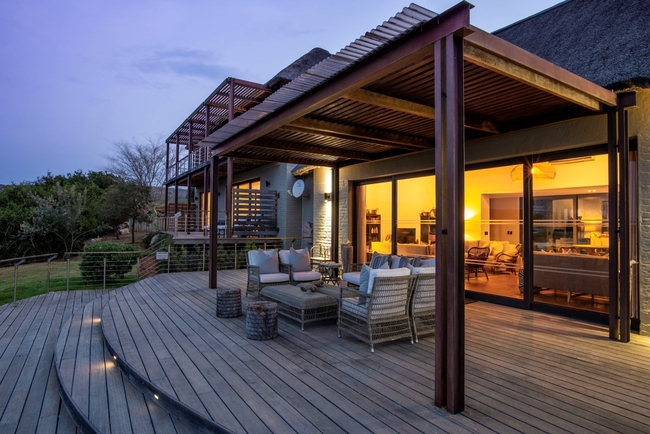
Shamwari Sarili Lodge
Sarili Lodge in the Shamwari Game Reserve is a luxury lodge exclusively for families. An environmentally friendly private African thatch designed...

Kwandwe Fort House
Warmth and comfort embodies the refined private spaces of the Fort House in Kwandwe Private Game Reserve. The private villa has been elegantly de...

Kwandwe Melton Manor
Kwandwe Melton Manor is a private space that inspires the sharing of meals, laughter and experiences around the farmhouse table. Grand views of t...

Kwandwe Uplands Homestead
The African wilderness of which childhood dreams are made is found at Kwandwe Uplands Homestead. An intimate private safari home imbued with old-...

Sandcastle Villa
Set amongst the natural beauty of the estate's fauna and flora, the awe-inspiring Sandcastle Villa was designed to imitate the land and boundless...

The Homestead at Kariega
Located in the makaria-free Kariega Game Reserve, The Homestead is a private lodge which offers its' guests all the comfort, convenience and luxu...

Long Hope Villa
Long Hope Villa is a beautifully restored exclusive safari villa, located in the Greater Addo Elephant National Park, on a private concession. Al...

Shamwari Sindile
Shamwari Sindile offers accommodation in a luxury tented camp located in Paterson in the Eastern Cape. Shamwari, meaning "my friend" in Shona, is...

Kwandwe Ecca Lodge
Set in the heart of the Private Reserve in thick vegetation overlooking a dense valley, Ecca Lodge offers breathtaking views onto an escarpment o...
Noteworthy attractions

Mkambati Nature Reserve
Flanked on either side by the forested ravines of the Msikaba and Mtentu Rivers, Mkambati Nature Reserve is 8000 hectares of coastal reserve that...

Seaview Lion Park
As you drive through the Seaview Predator Park with an amazing 360 degree view of the Indian Ocean you will see the free roaming Giraffe, Zebras...

Donkin Heritage Trail
The Donkin Heritage Trail is named after the Acting Governor of the Cape Colony at the time, Sir Rufane Donkin. South Africans are well acquainte...

Fort Frederick
Like many national monuments, Fort Frederick first appears as little more than a few brick walls, albeit old walls that seem to hold little signi...

St Georges Park Cricket Ground
The oldest park in Port Elizabeth and the site of the second oldest cricket club in the country, St Georges Park lies in the heart of Port Eliza...

Humewood Golf Club
One of South Africas top-rated golf clubs, Humewood is a true Links course which has hosted numerous PGA events, including the South African Ope...

Bayworld Museum Complex
The Main Museum of Bayworld blends cultural and natural history. Embark on an exciting journey through time and through the fascinating world aro...

Eastern Cape Beaches
The Eastern Cape in South Africa boasts some of the worlds best beaches and 800 km of unspoilt picturesque coastlines where blue oceans tumble o...

Hole In The Wall
The Hole in the Wall at Coffee Bay is a unique structure with a huge detached cliff that has a giant opening carved through its centre by the wav...
Eastern Cape as a destination
When would you like to stay? Choose dates
Number of Guests
Why book with sa-venues.com.
- Your card is safe with us; strictest card verification in the industry and we don't store card numbers.
- No airy fairy service fees; you save!
- We care. Service with integrity.
- Multiple payment methods: credit card, SID instant EFT, bank transfer.
- All Eastern Cape property owners / managers are verified (our experience protects you from online fraud).
- Secure your booking
- Eastern Cape
- Garden Route
- KwaZulu Natal
- North West Province
- Northern Cape
- Western Cape
- Introduction to the Eastern Cape
- Tourist Attractions & Destinations
- Eastern Cape Weather and Climate
- Eastern Cape Maps
- Eastern Cape Articles (on the Blog)
- Eastern Cape Accommodation
- Eastern Cape Hotels
- Eastern Cape Guest Houses
- Eastern Cape Bed & Breakfast
- Holiday Apartments & Suites
- Holiday Cottages & Chalets
- Holiday Homes & Villas
- Eastern Cape Honeymoons
- Game Lodges
- Special Categories
- By Star Grading
- Eastern Cape Search by Map
- Eastern Cape Weddings
- Eastern Cape Conferences
- Eastern Cape Tours
- Tour Operators
- Tour Guides
- Package / Overnight Tours
- Day Trips and Excursions
- Self Drive Tours
- Things to Do in Eastern Cape
- Game Reserves
- Golf Courses
- Eastern Cape Hiking Trails
- Eastern Cape 4x4 Trails
- Restaurants & Night Life
- Health Resorts & Spas
- Backpacking

- South African Rand
- Information
- Introduction to South Africa
- Tourist Attractions
- Maps / Atlas
- South Africa Travel Blog First-hand accounts, tips and experiences in our beautiful country
- By Province
- South Africa Hotels
- Guest Houses
- Bed and Breakfast
- Self Catering
- Game Lodges / Safaris
- Search By Map
- Interests & Special Needs Pet- and wheelchair-friendly, guest farms, golf lodges, safaris, hot tubs, birding, etc
- Special Offers
- Johannesburg
- Port Elizabeth
- Kruger Park
- Cape Winelands
- Drakensberg
- Western Cape Hotels
- KwaZulu Natal Hotels
- Gauteng Hotels
- Mpumalanga Hotels
- Limpopo Hotels
- North West Hotels
- Free State Hotels
- Northern Cape Hotels
- Popular Searches
- Cape Town Hotels
- Garden Route Hotels
- Durban Hotels
- Johannesburg Hotels
- Proudly South African
- Adventures & Outdoor Activities
- Restaurants in South Africa
- Hiking Trails
- Wine Estates
- Botanical Gardens
- World Heritage Sites
- Made in South Africa
- Languages & Culture
- Conferences
- Contact SA-V
- Privacy Policy
- Copyright / Legal
- Terms of Use
- Establishment Login
Why book with us?
- Strictest card verification in the industry. Your card is safe with us.
- We don't store credit card details so they can't be compromised.
- Responsible travellers buy local. We're proudly South African!
- Protection from online fraud: all property owners are verified.
- Your privacy guaranteed. We won't share your contact details. Ever.
- We don't charge airy-fairy service fees; so you save!
- Want more reasons?
Let us inspire you
SA-Venues.com® has been assisting travellers with their South Africa travel plans since 1999, and is the largest, independent online travel guide for South Africa available in both English and German.
SA-Venues.com © 1999-2024. All Rights Reserved. Find and book hotels and accommodation in South Africa. Sitemap

Getting around
Before you go, holiday types, baviaanskloof world heritage site, double mouth, mpofu – fort fordyce, ongeluksnek, commando drift, thomas baines, great fish river, garden route, mountain zebra, addo elephant, inkwenkwezi private game reserve, mpongo private game reserve, samara private game reserve, koffylaagte game lodge, mount camdeboo private game reserve, kariega private game reserve, amakhala private game reserve, pumba private game reserve & spa, lalibela big 5 game reserve & safari lodge, kwandwe private game reserve, shamwari private game reserve, kwantu private game reserve, oceana beach and wildlife reserve, hopewell game reserve, sibuya game reserve and tented camps, kragga kamma game park, thunzi bush lodge, schotia safaris private game reserve, addo elephant park private concession lodges, lombardini game farm, explore our interactive map, destinations, heritage sites, performing arts, township tours, village experiences, entertainment centres, horse riding, snakes and reptiles, dolphin watching, game drives, wildlife parks, motor cycling, quad biking, rock climbing, trail running, water skiing, boat cruises, bird watching, arts and crafts, art galleries, mountain biking, food & wine, driving journeys, dinosaur & fossiling, camping & 4×4, ocean safari’s, diving & snorkelling, somerset east charity golf day, switching on of christmas lights – buffalo city, makana music festival, london roots, ebubeleni music festival, ecawa music festival, nieu bethesda festival of lights, tenza beach festival, isingqi sethu exhibition, coffee bay cultural festival, berlin november, all white heritage day picnic.
Home / Places To Go
View Regions
Places to go.
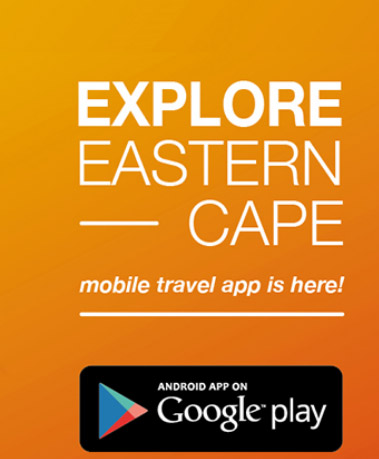
+27 (0)43 492 0881
Quick links
About Us Parks Reserves Travel Information Accommodation PAIA Manual PAIA Guide English PAIA Guide Xhosa PAIA-Guide-Afrikaans
PAIA Request for Access PAIA Form 3 PAIA Form 4 Events Attractions & Activities Media Centre Blog Corporate Site POPIA Privacy Notice
Download Our Travel App

Subscribe to our newsletter

Copyright © ECPTA
Powered by Pii Digital

IMAGES
COMMENTS
13. Route 67. 14. Chintsa. Map of Tourist Attractions in the Eastern Cape. 1. The Valley of Desolation. The Valley of Desolation. In Camdeboo National Park, which surrounds the town of Graaff-Reinet, the Valley of Desolation is one of the most striking natural features on the Eastern Cape.
Explore Route 67 - One of The Eastern Cape Tourist Attractions. Route 67 in Port Elizabeth celebrates Mandela's legacy with several attractions dedicated to him. It is a self-guided walking route of 67 pieces of art inspired by Mandela. The number 67 represents the 67 years Mandela served the public (including his 27 years in prison).
The Eastern Cape, with its mild climate, renowned beauty and natural biodiversity is an outstanding destination rich with potential. Some 15 kilometres south of the pretty coastal city of Port Elizabeth (Gqeberha), at the southern point of Algoa Bay, is the 366 ha (900 acre) Cape Recife Nature Reserve, proclaimed in 1973.
The Eastern Cape, with its mild climate, renowned beauty and natural biodiversity is an outstanding destination rich with potential. Some 15 kilometres south of the pretty coastal city of Port Elizabeth (Gqeberha), at the southern point of Algoa Bay, is the 366 ha (900 acre) Cape Recife Nature Reserve, proclaimed in 1973.
Attractions & Activities. From music and the arts, to cultural and heritage tours, expos and outdoor excursions, lifestyle festivals and a range of seasonal sporting events, find a full list of attractions and activities to explore in the Eastern Cape.
6. Jeffreys Bay. Jeffreys Bay, or J-Bay as the locals call it, is a surfer's paradise. Famous for its world-class waves, it's one of the most beautiful places in the Eastern Cape for water sports enthusiasts. The bay's long, fast, beautifully formed waves make it a hit among surfers worldwide.
Ecoshrine. Eastern Cape. Well-known mixed-media artist Diana Graham, a passionate environmental advocate, has created a concrete sculpture garden dedicated to the forces of nature…. 1. 2. Discover the best attractions in Eastern Cape including Valley of Desolation, Nelson Mandela Museum, and Camdeboo National Park.
These are the best places for kid-friendly sights & landmarks in Eastern Cape: Storms River Suspension Bridge; Cape Recife Lighthouse Villa; Hole in the Wall; Dutch Reformed Church, Groot Kerk; Storms River Bridge (Paul Sauer Bridge) See more sights & landmarks for children in Eastern Cape on Tripadvisor
The Eastern Cape's Wild Coast runs along a rugged coast of untouched shorelines, shipwrecks and traditional Xhosa Culture. From marine safari activities to local cultural encounters and adrenaline adventures, the Wild Coast shows off with exquisite coastal scenery and outdoor excursions fit for the whole family.
Please visit the official Shamwari Game Reserve Lodges page on TripAdvisor for more info, images, video & slideshow. Search "Shamwari Game Reserve lodges".Shamwari is the best private game reserve situated in the malaria free Eastern Cape,South Africa.This privately owned 25 000 hectares of prime natural terrain has received numerous international awards.Shamwari is an exploration of nature ...
Eastern Cape Tourism. Home to four of South Africa's national parks as well as numerous private and provincial nature reserves, the Eastern Cape boasts the World Heritage Site, Baviaanskloof Nature Reserve. This nature reserve is known worldwide as South Africa's largest wilderness area and as one of the country's eight Cape Floristic ...
The Eastern Cape may not have as many fine-dining restaurants as Cape Town and its surrounding winelands, but cities like East London have increasingly exciting culinary scenes. Locals and visitors flock to Sanook, a gourmet pizza, pasta, and burger restaurant with two branches—one in Berea, the other in Beacon Bay.
Africa. From lush tropical forests to uninhabited desert expanses, and from easy-going hammock time to adrenaline-pumping adventures, the Eastern Cape offers a wide range of topography and experiences. Compared with the more developed Western Cape, it can feel like a different country and provides opportunities to learn about Xhosa culture.
Eastern Cape Tourism: Tripadvisor has 203 128 reviews of Eastern Cape Hotels, Attractions, and Restaurants making it your best Eastern Cape resource.
9. Mountain Zebra National Park [SEE MAP] Established in 1937 to protect and preserve the natural habitat of the Cape Mountain zebra, this wonderful national park actually boasts many other species, with lions, cheetahs, buffaloes, and rhinos all found within its confines. Whether you explore the park's many paths or roads on foot or by 4X4 ...
Rough Guides® is a trademark owned by Apa Group with its headquarters at 7 Bell Yard London WC2A 2JR, United Kingdom. Plan your visit to The Eastern Cape, South Africa: find out where to go and what to do in The Eastern Cape with Rough Guides. Read about itineraries, activities, places to stay and travel essentials and get inspiration from the ...
Join us as we embark on a journey through the Eastern Cape to discover some of our iconic heritage landmarks and attractions as explore the intersections of heritage and tourism. Nelson Mandela Museum, Mthatha, Wild Coast. The Nelson Mandela Museum in Mthatha, Eastern Cape, stands as a profound tribute to the life and legacy of one of the world ...
Nes (Naasly Swiers) on our visit, these were brought to life by a series of tapestries and artwork and his passion. 13. Double Mouth Nature Reserve. 48. Nature & Wildlife Areas. By oppie2014. A beautiful secluded coastal strip below the breathtaking Morgan Bay Cliffs along the Eastern Cape Wild Coast. 14.
Here are some of the top tourist attractions of the Eastern Cape: Home to about 500 free-roaming African Elephants; as well as lion, buffalo, zebra, ostrich, warthog, plenty of antelope species and the famous endemic flightless dung beetle; Addo is a wonderful way to enjoy the abundance of the Eastern Cape. Self-driven tours as well as formal ...
From marine safari activities to local cultural encounters and adrenaline adventures, the Wild Coast shows off with exquisite coastal scenery and outdoor excursions fit for the whole family. ... Eastern Cape Parks & Tourism Agency 17-25 Oxford Street East London CBD 5201 Eastern Cape Province South Africa +27 (0)43 492 0881. [email protected] ...
Attractions Map of the Eastern Cape. Map showing the most popular tourist attractions, destinations and sites of interest in the Eastern Cape, South Africa. Whether you're in the mood for an informal seaside escape, an encounter with the "Big Five" on safari, or a choice of scintillating city diversions, you're sure to find what you're looking ...
Top Outdoor Activities in Eastern Cape, South Africa. 1. Addo Elephant Full Day Safari with a Traditional South African Braai (BBQ) Lunch. The Addo Elephant National Park is the 3rd largest national park in South Africa and is home to over 600 elephants, lion…. 2.
Attractions & Activities. Heritage Sites. Performing Arts. Township Tours. Village Experiences. Entertainment Centres. Horse Riding. Snakes and Reptiles. Dancing. Lifestyle. ... Eastern Cape Parks & Tourism Agency 17-25 Oxford Street East London CBD 5201 Eastern Cape Province South Africa +27 (0)43 492 0881. [email protected]. Quick links. About ...